
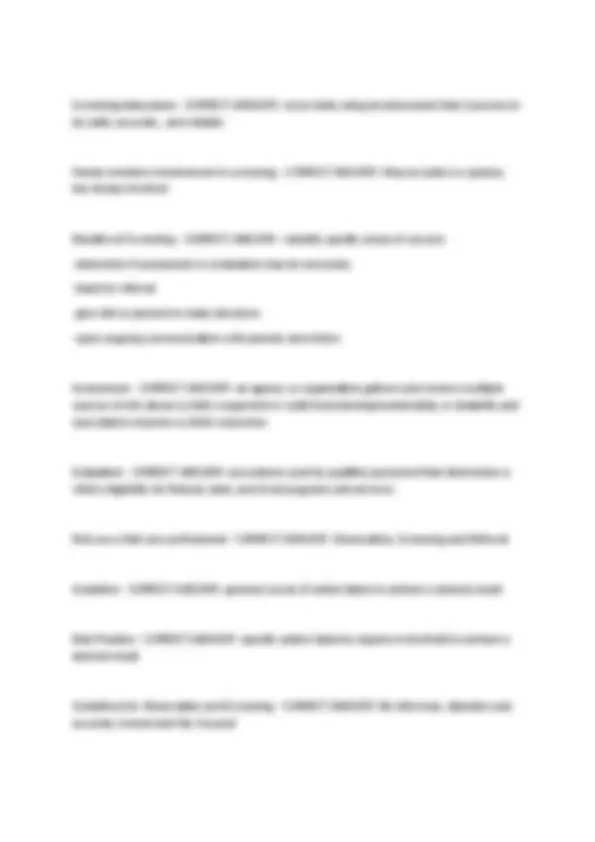

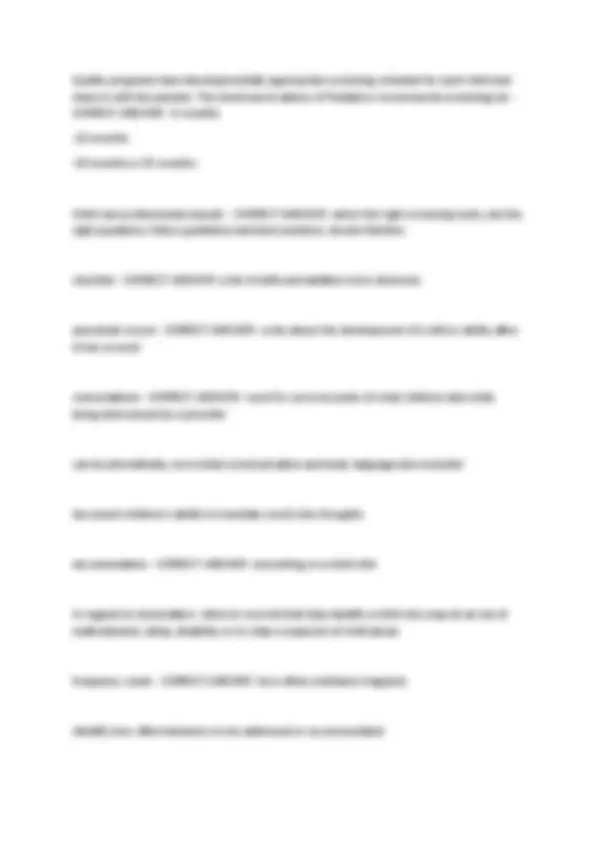
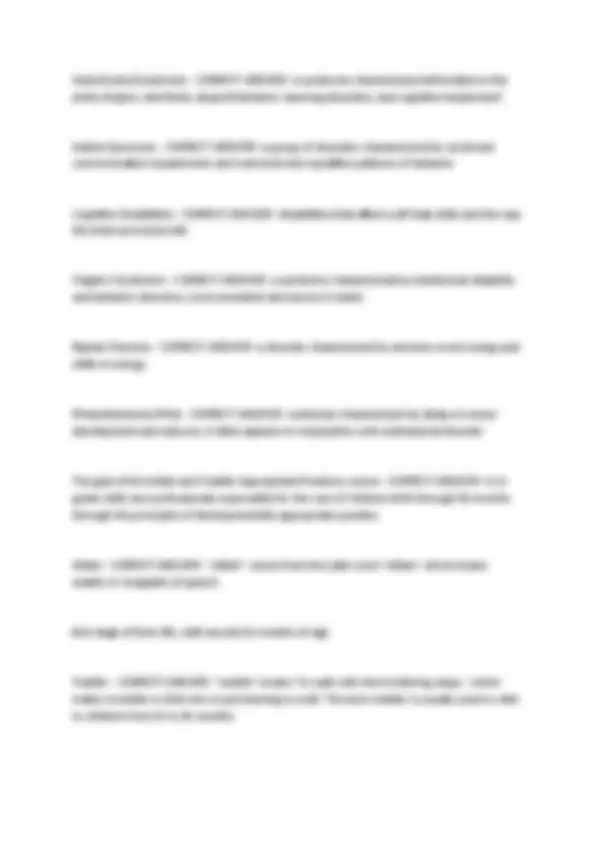
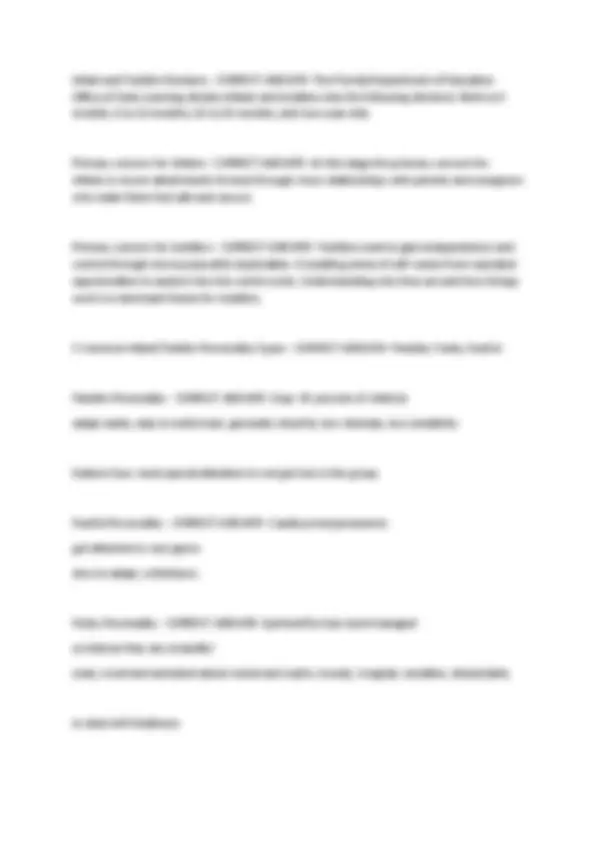
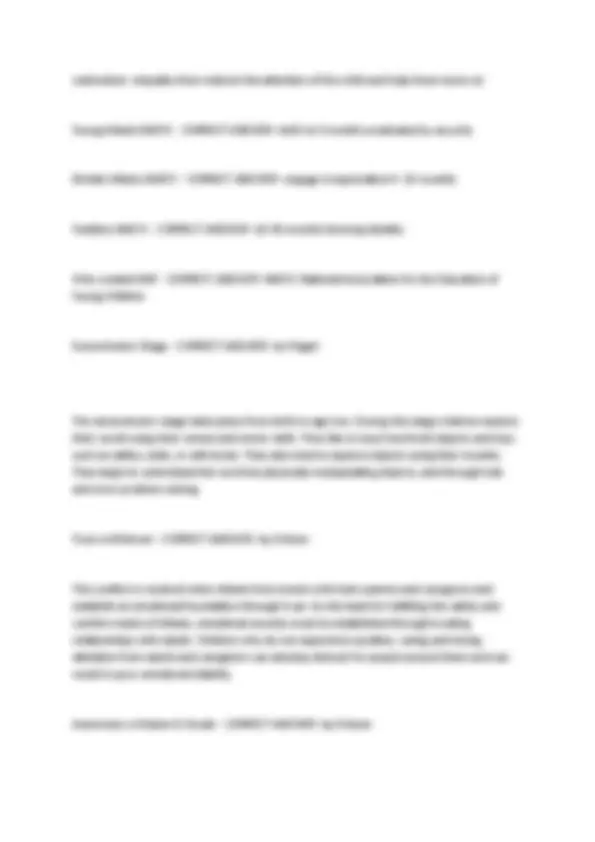
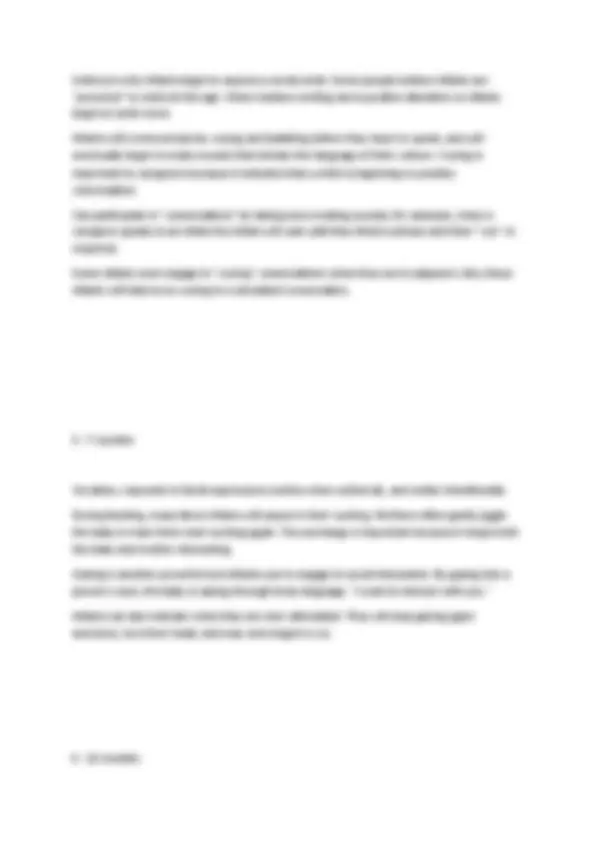
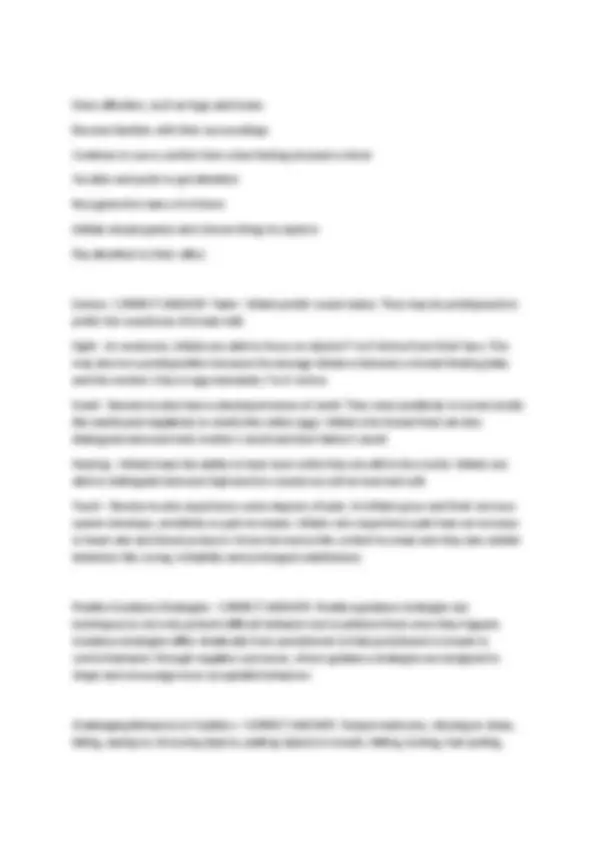
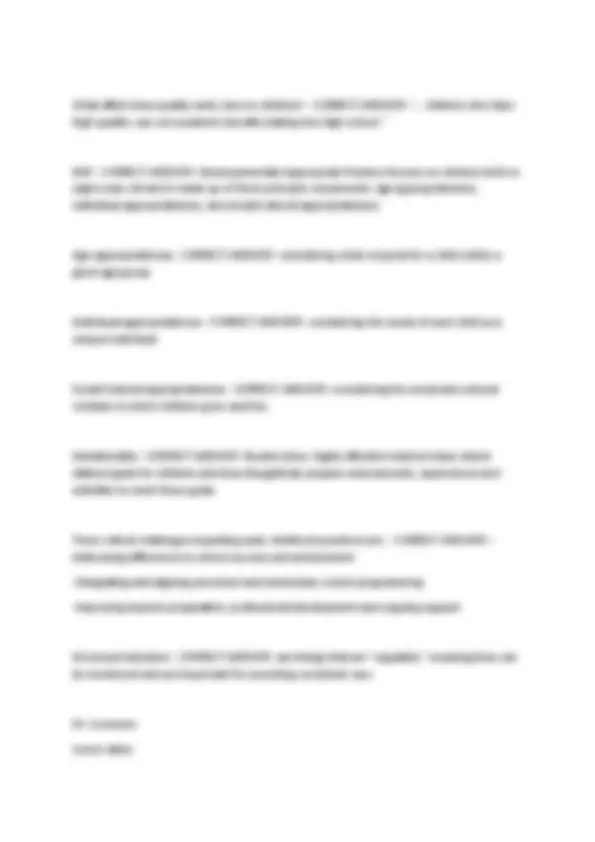
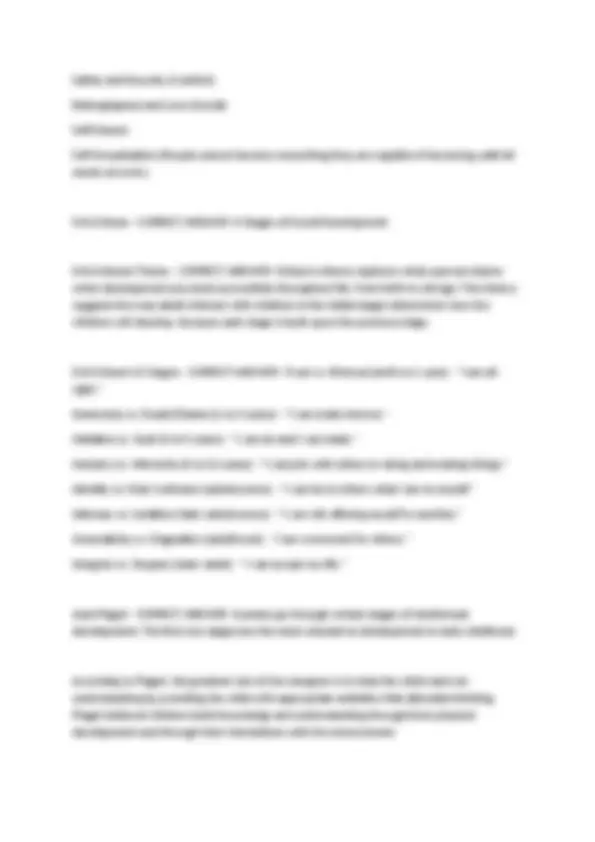
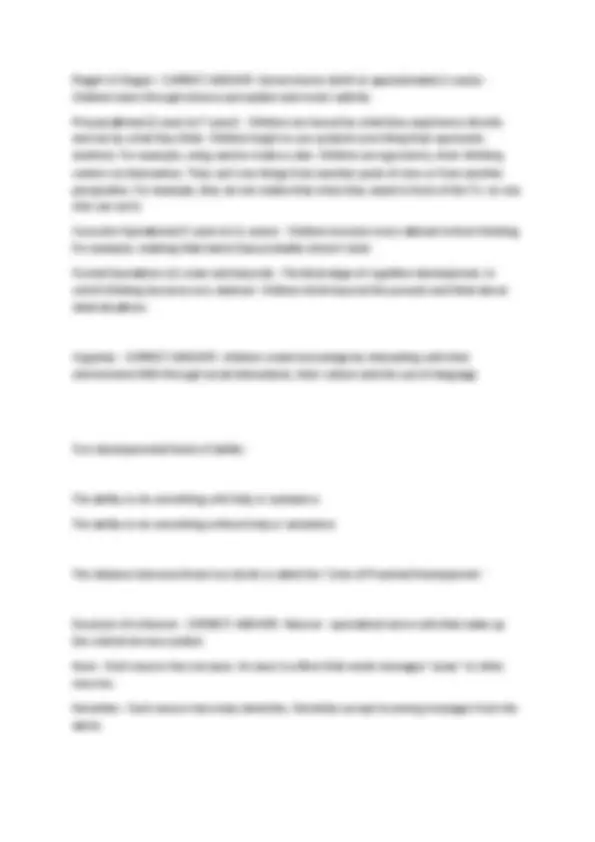
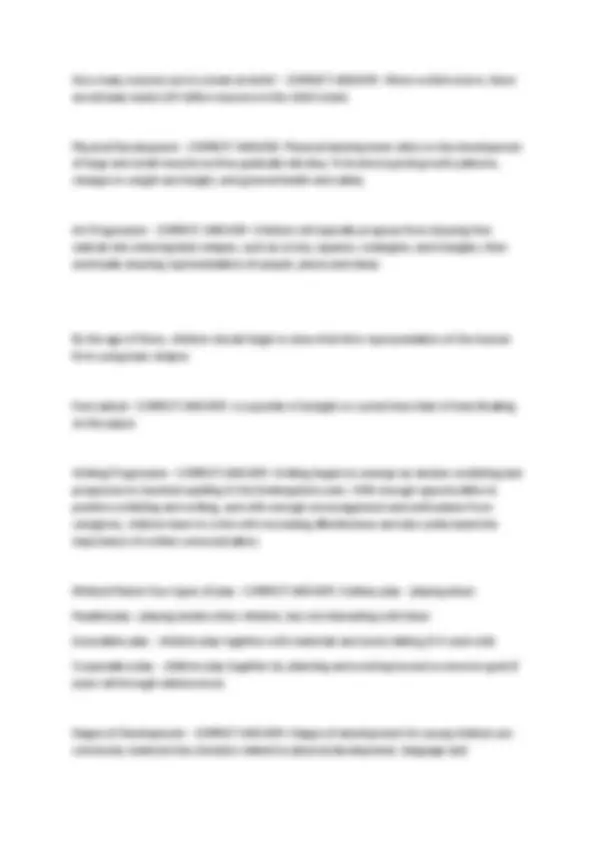
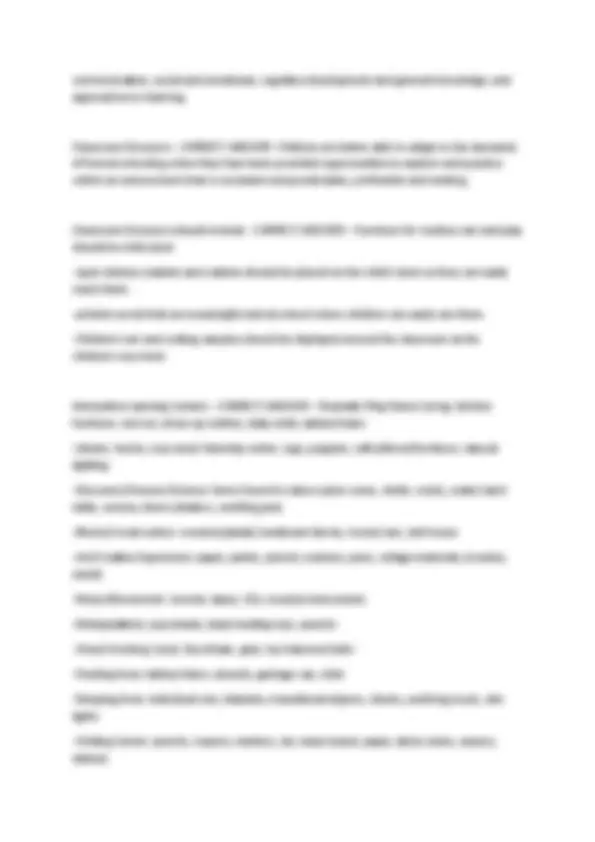
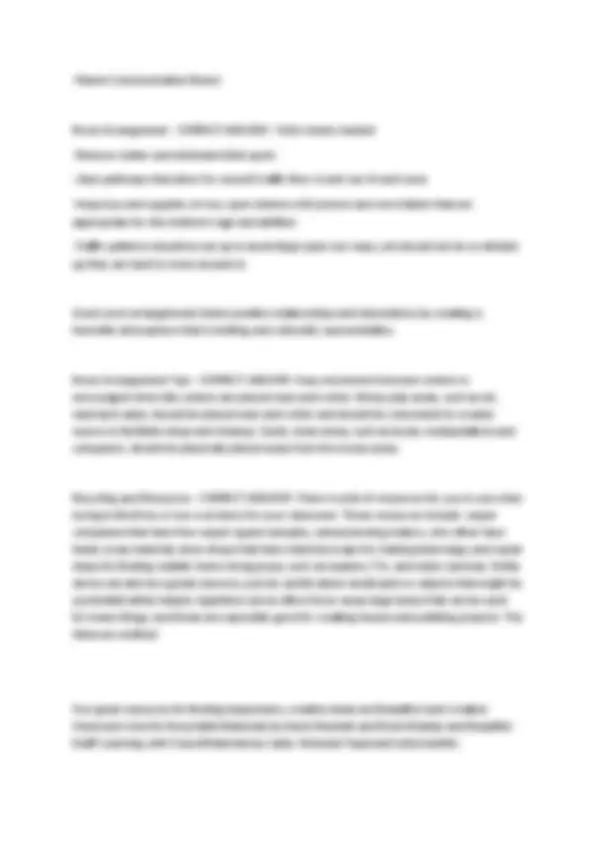
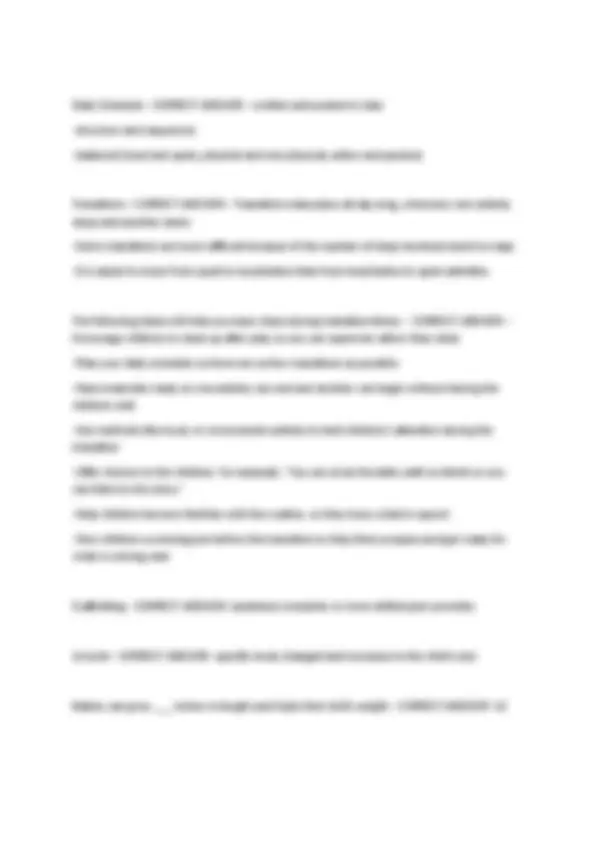
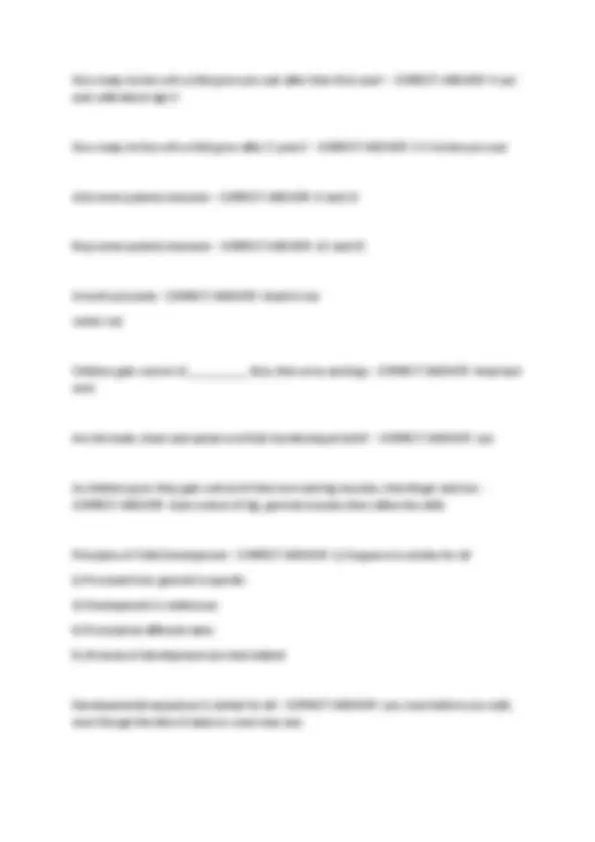
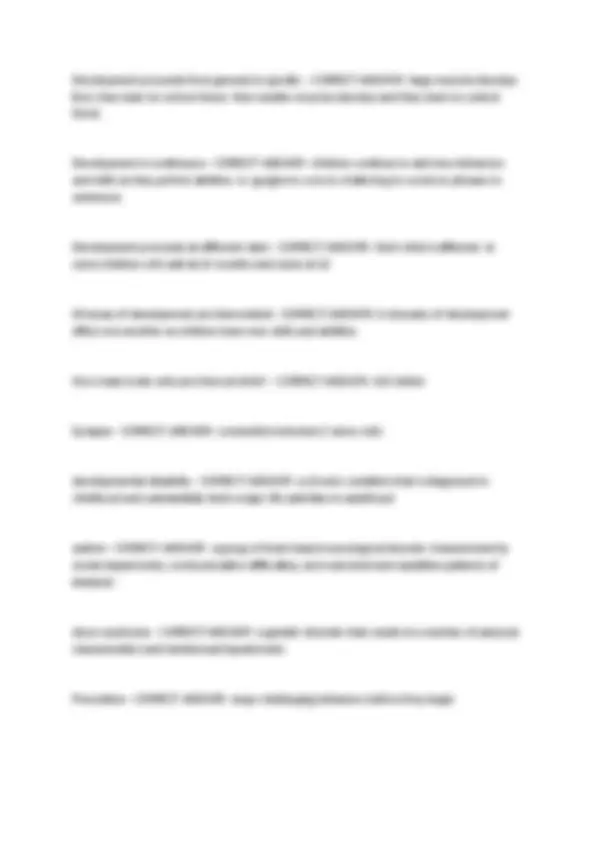
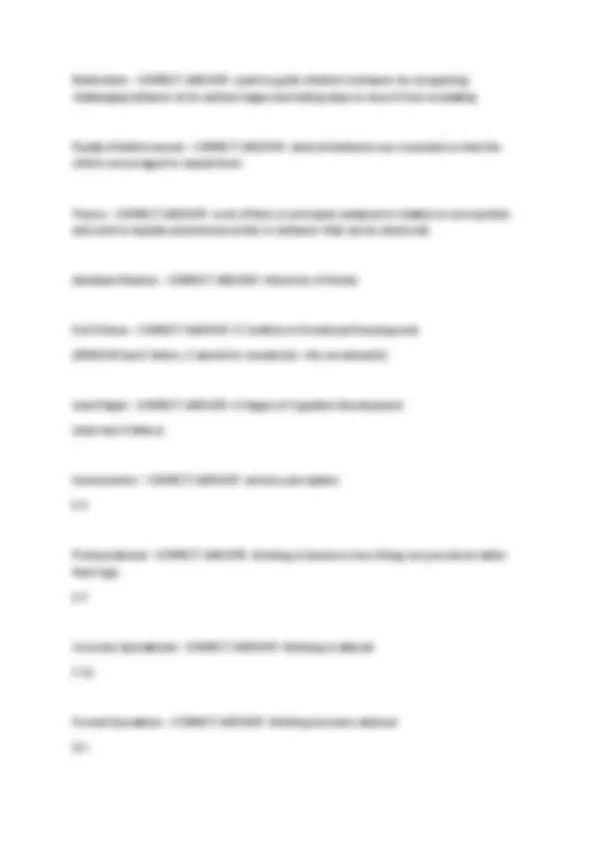
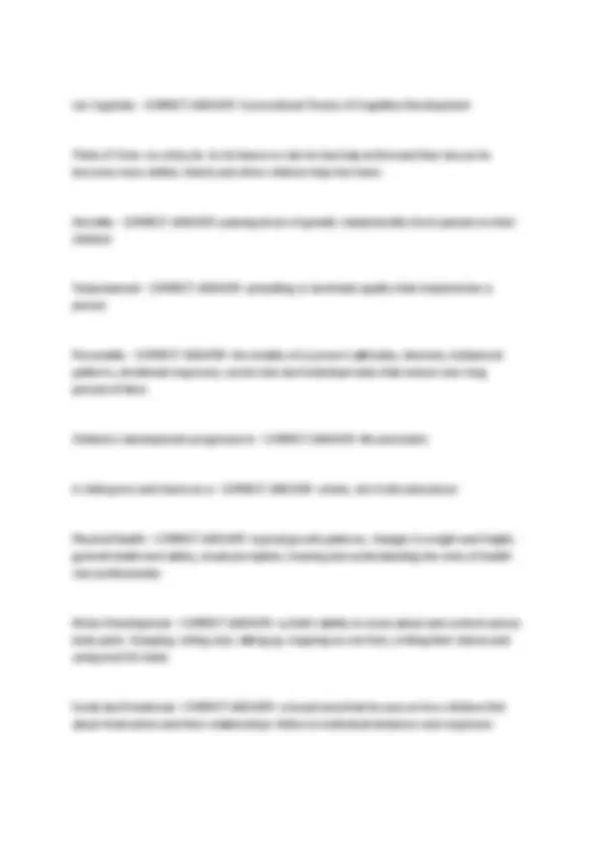
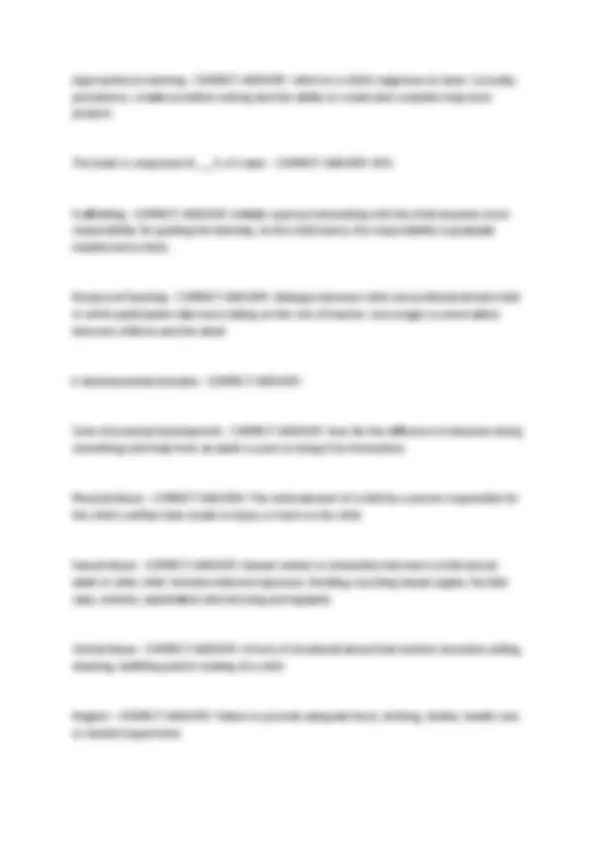
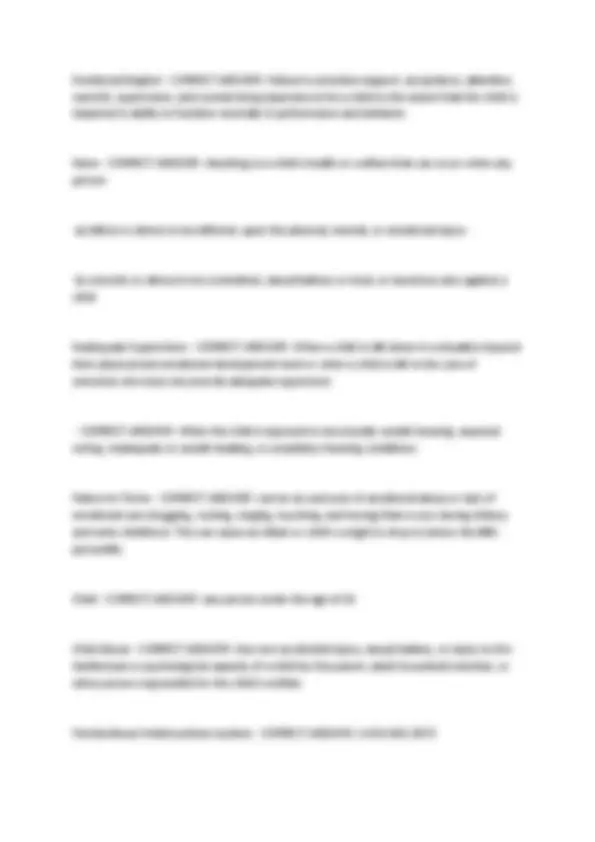
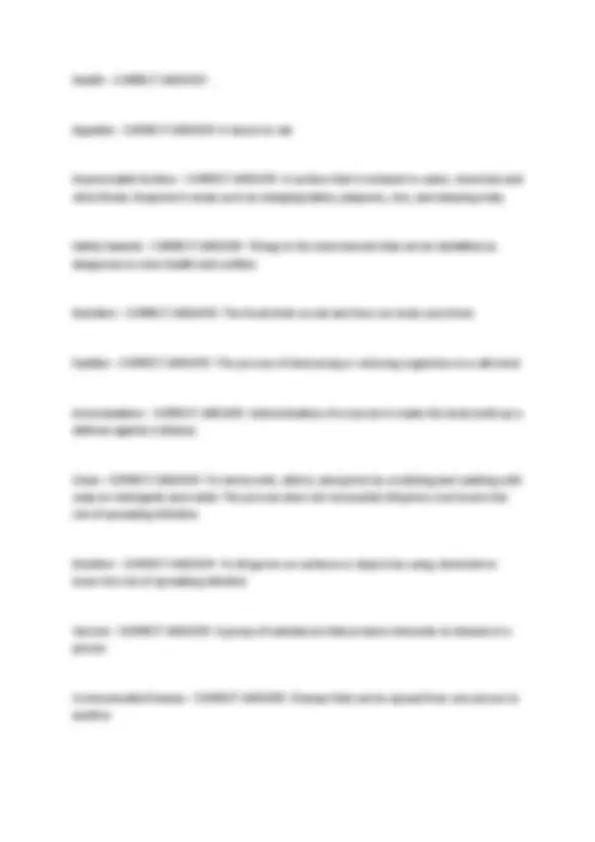
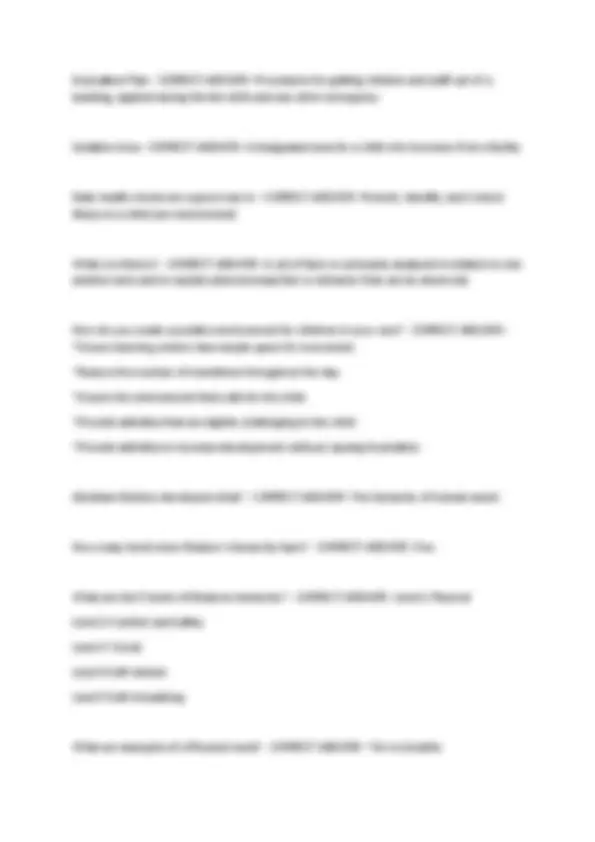
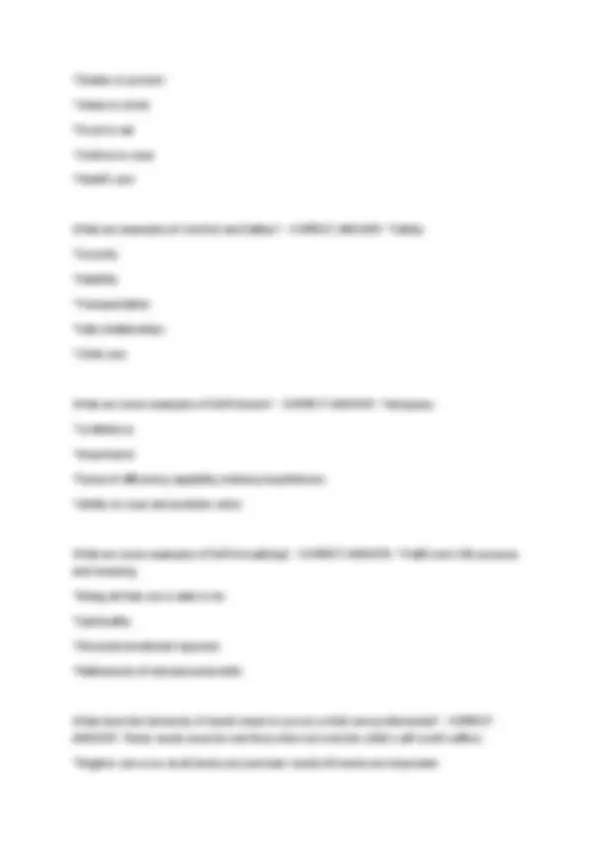
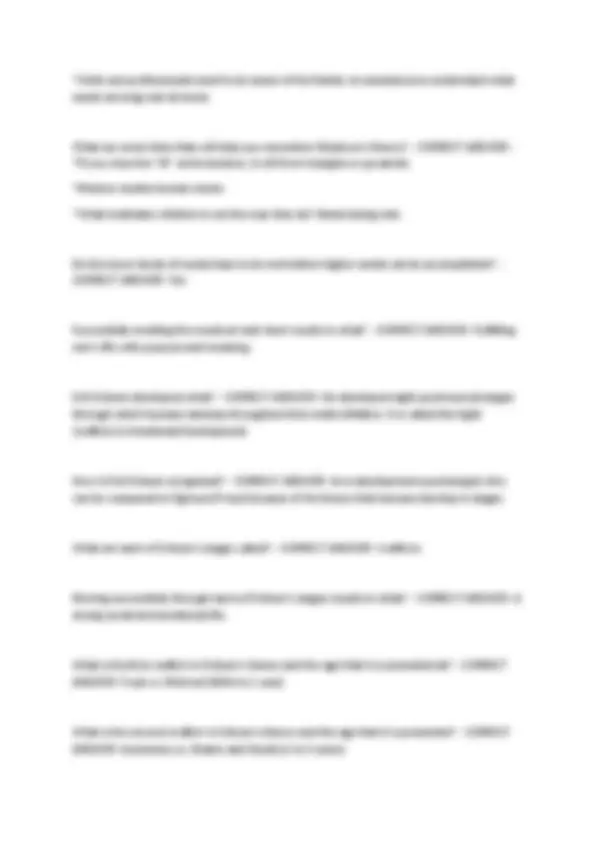
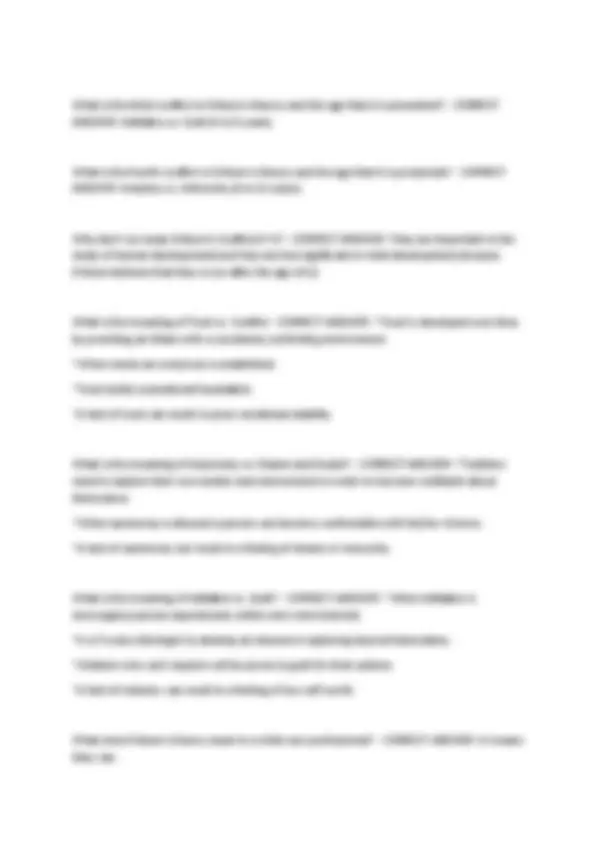
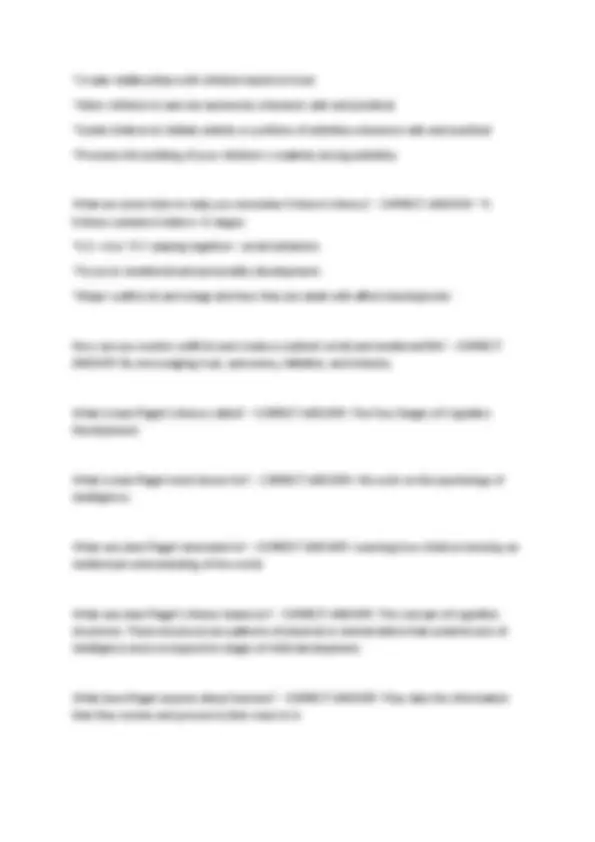
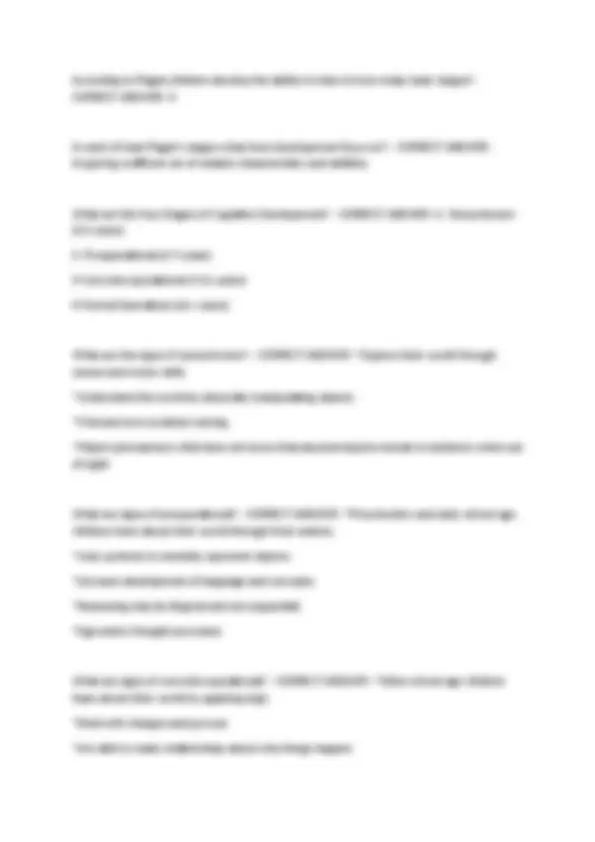
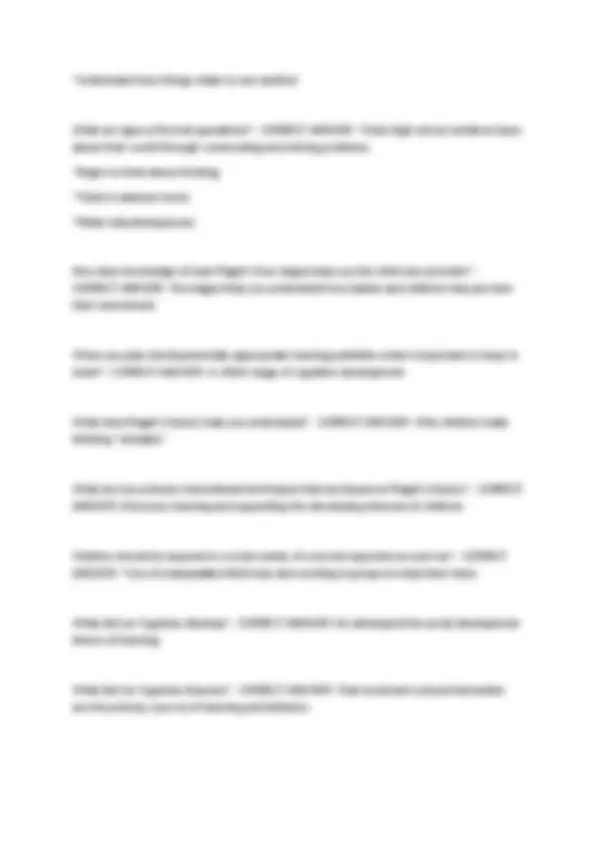
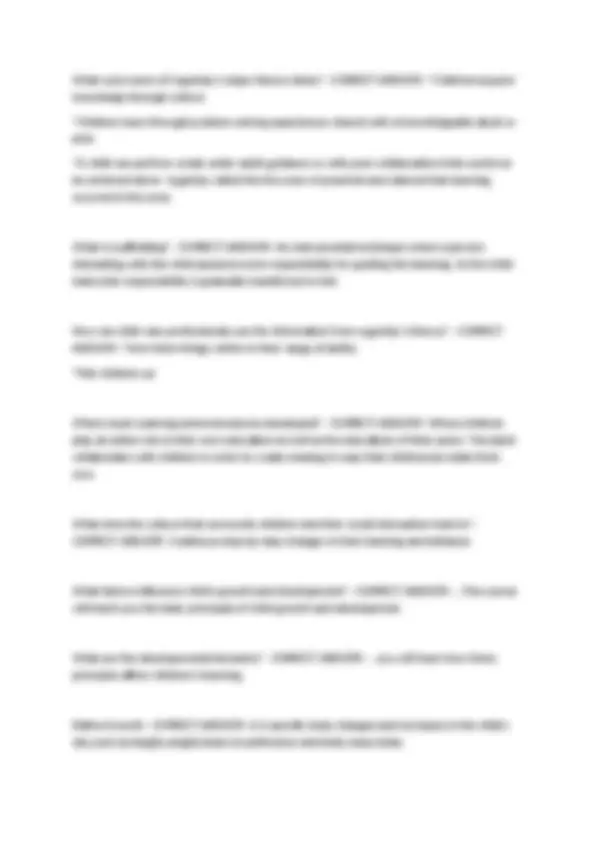
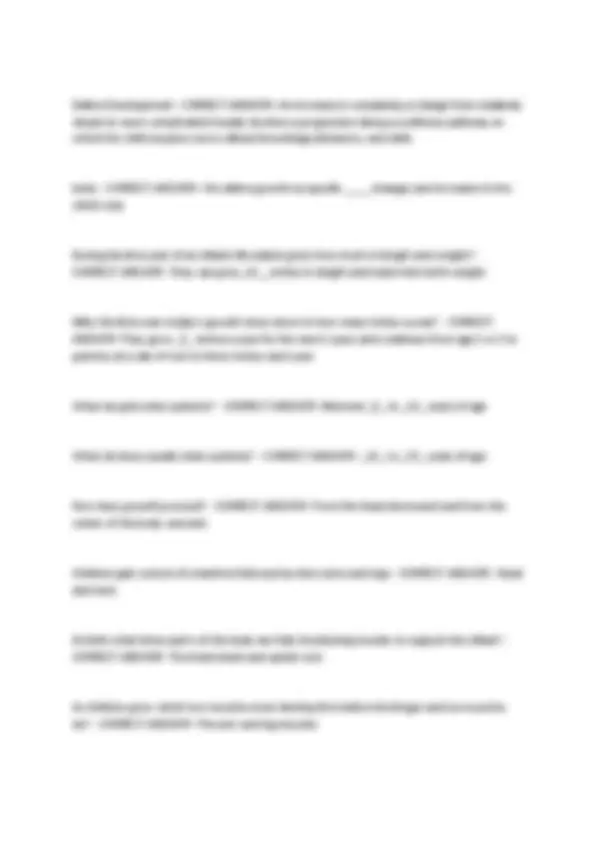
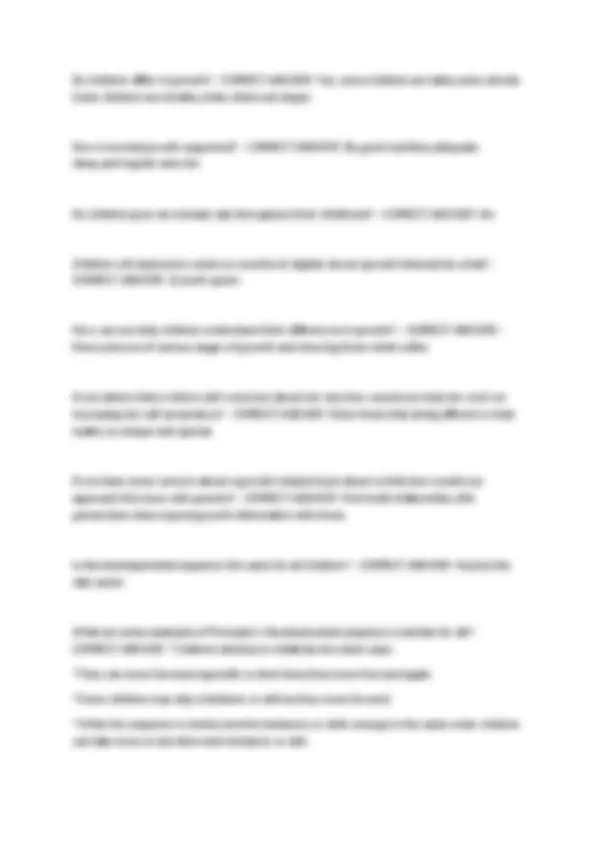
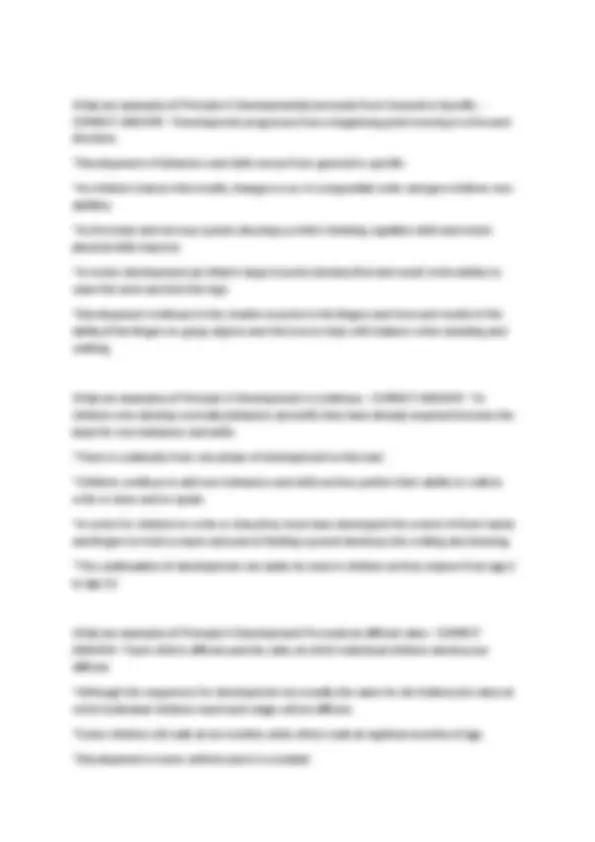
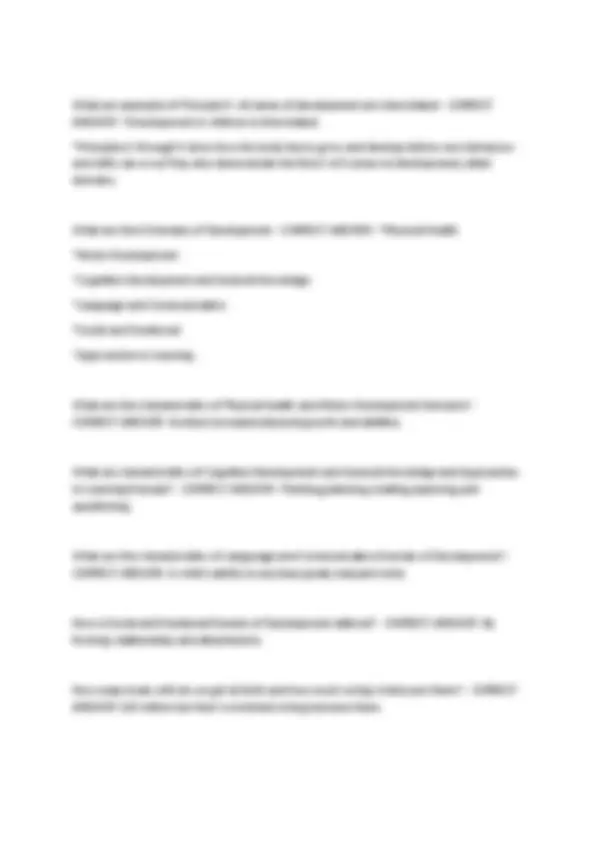
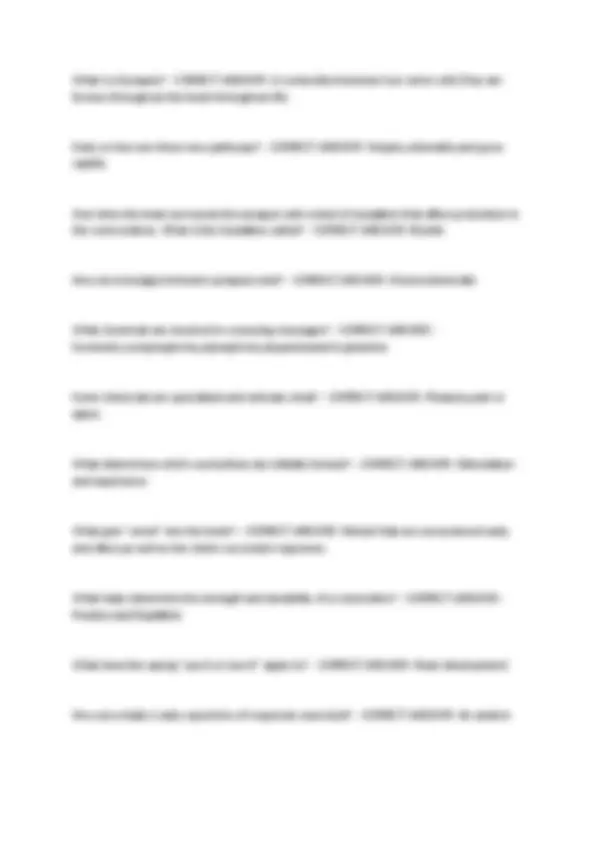
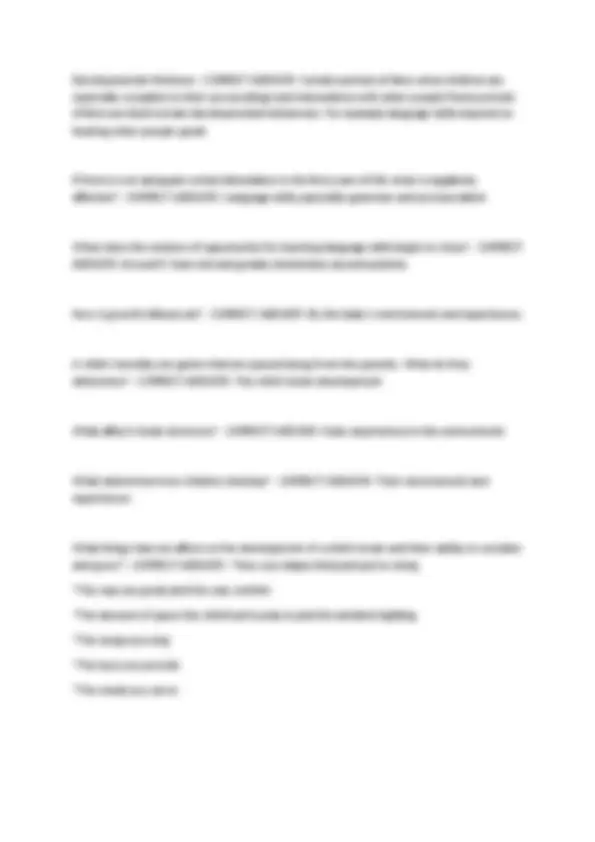
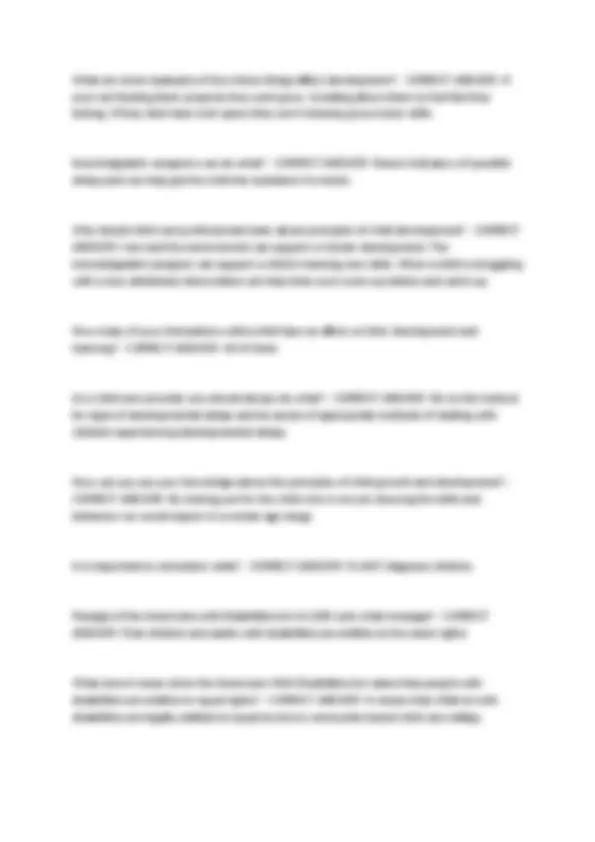
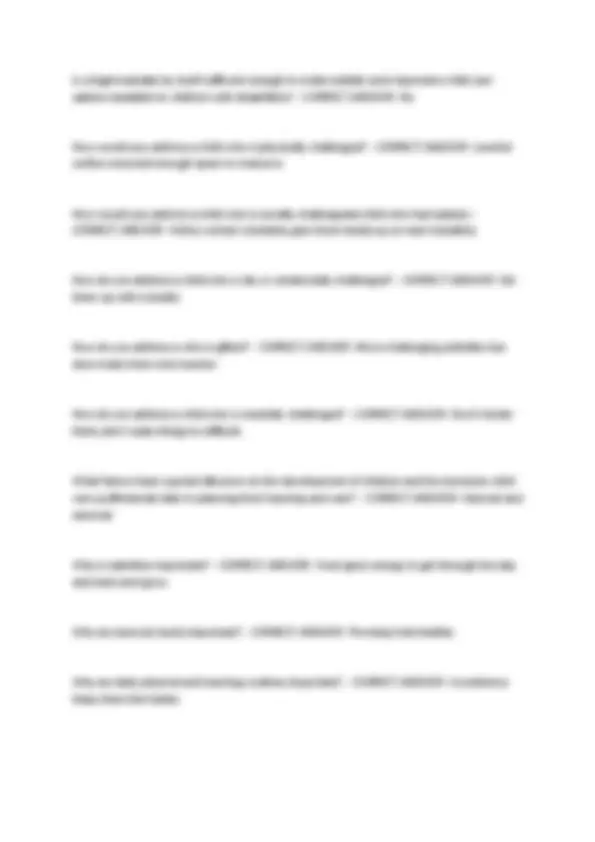
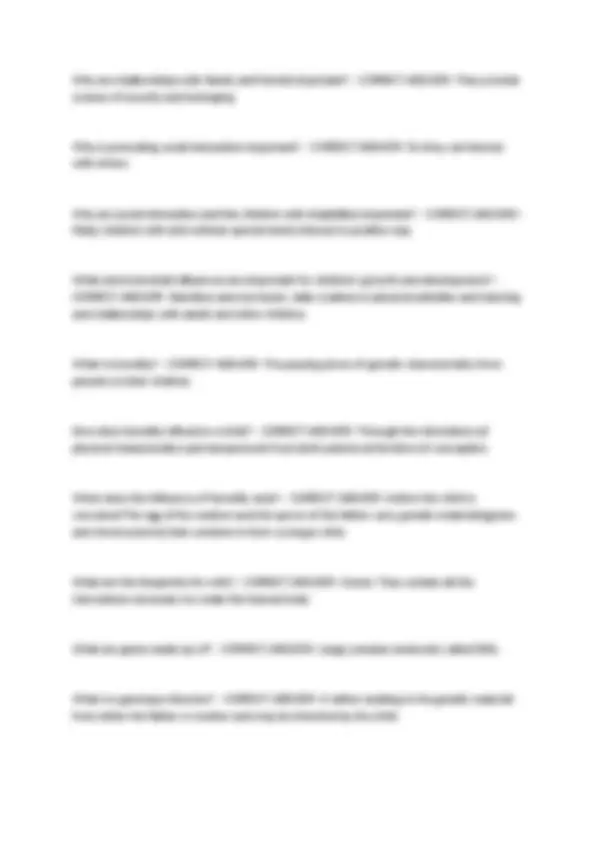
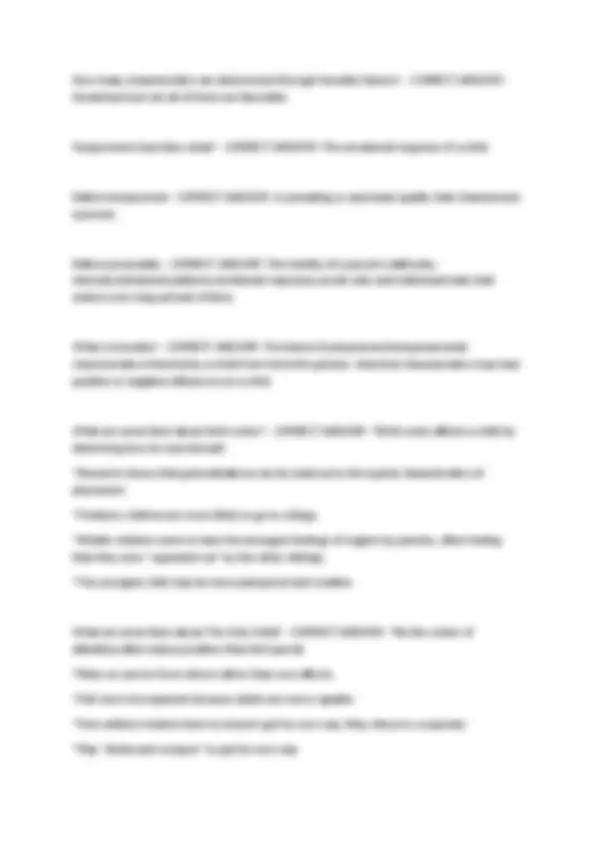
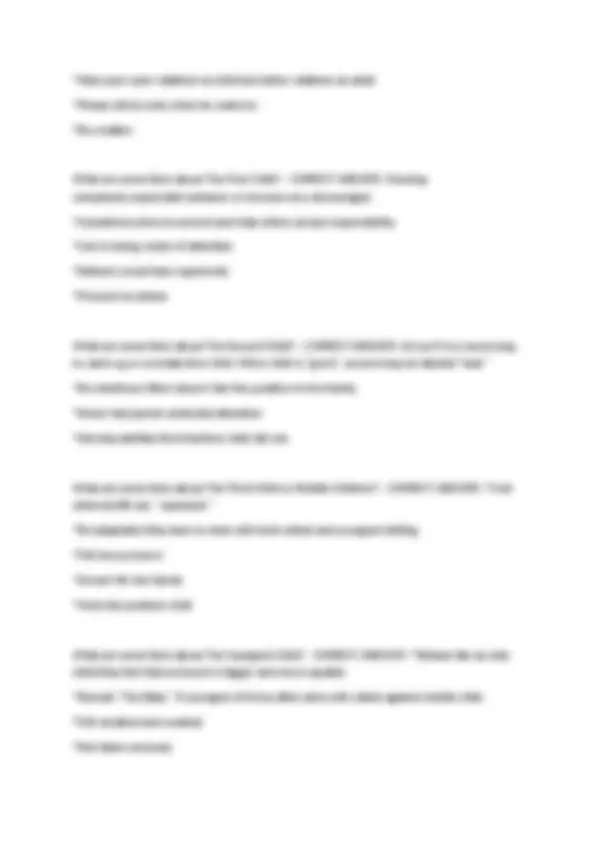
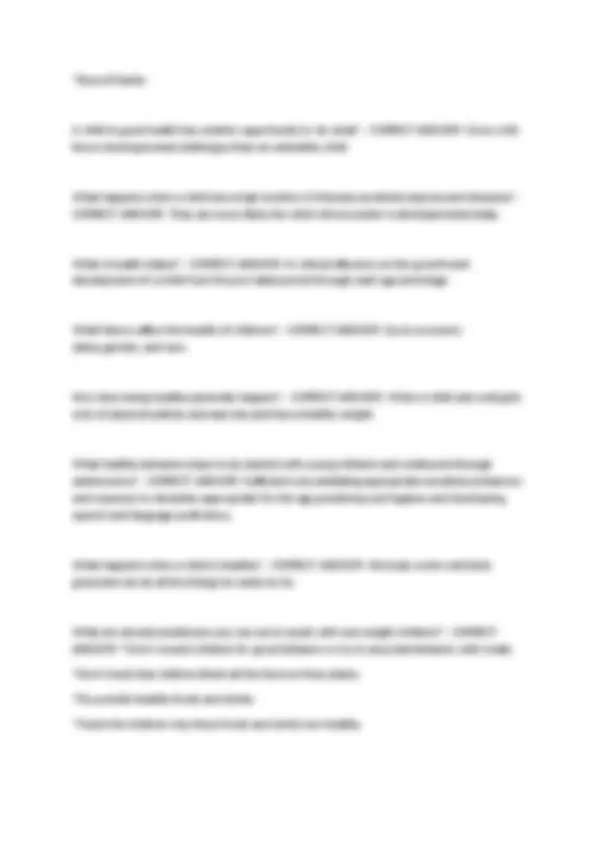
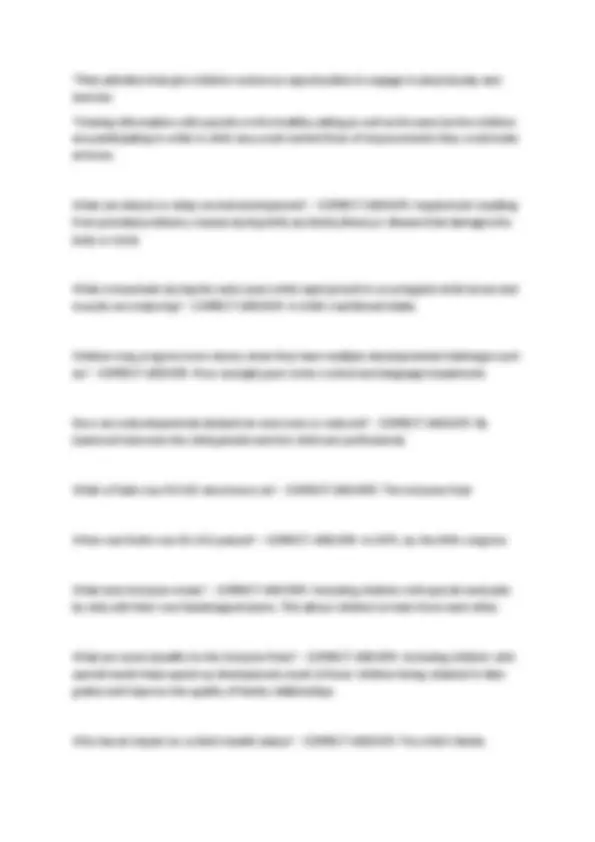
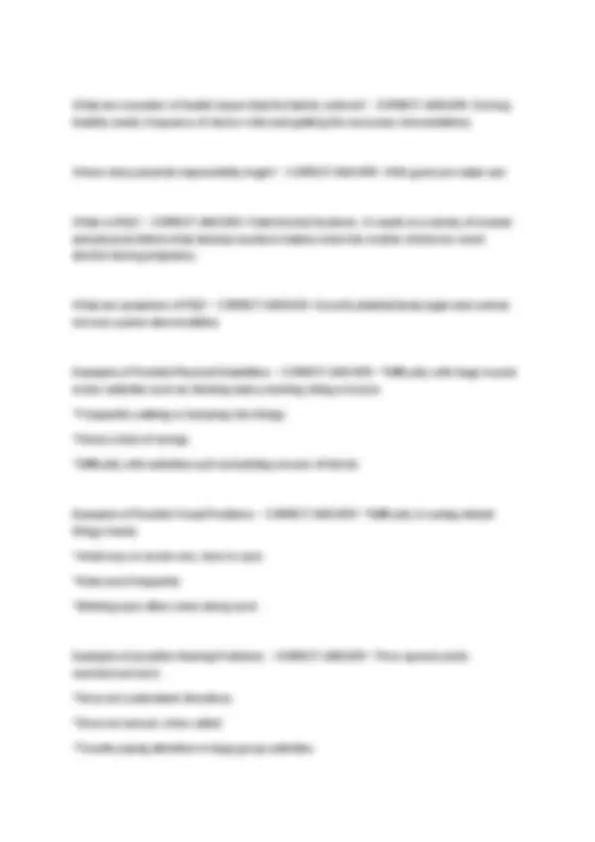
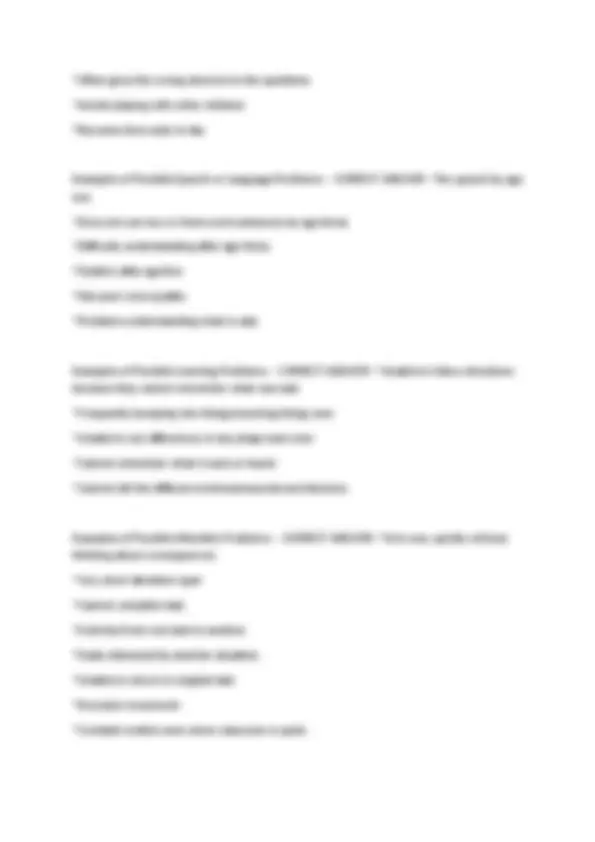
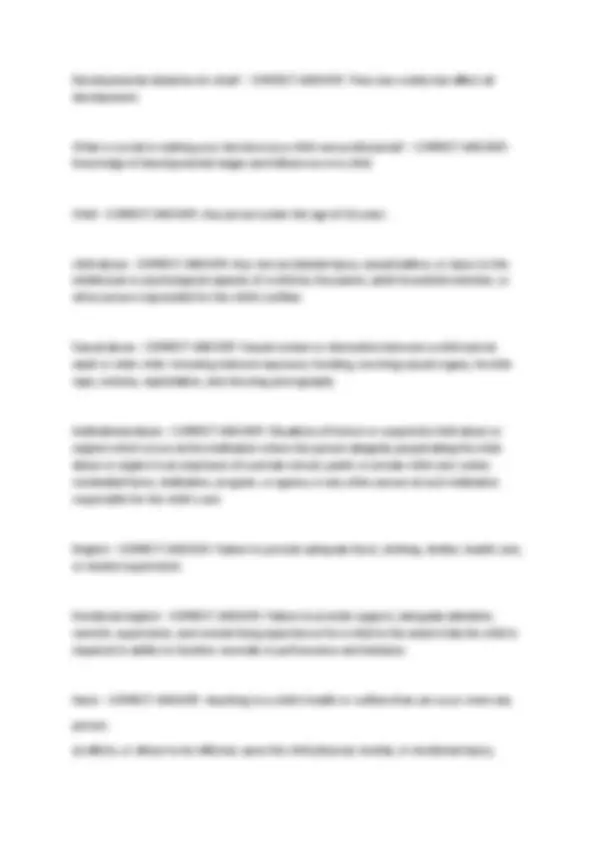
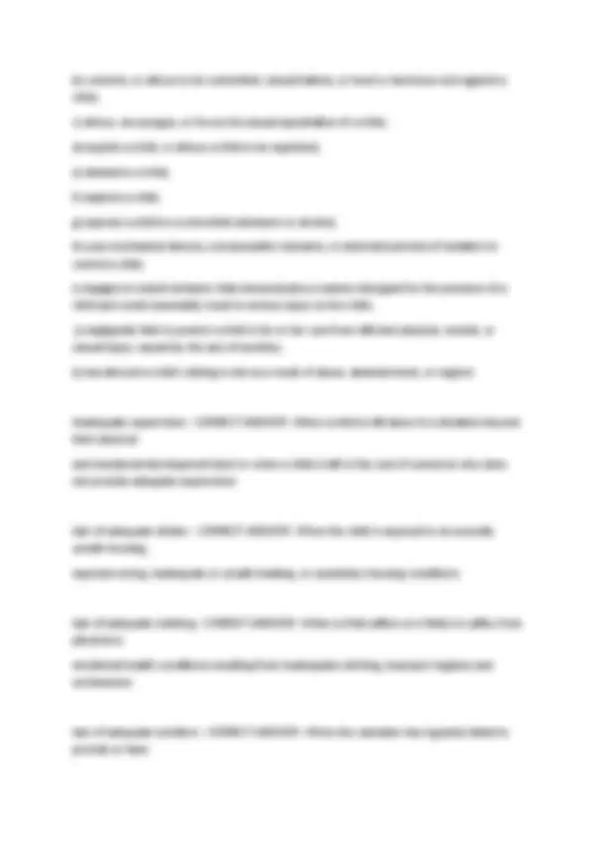
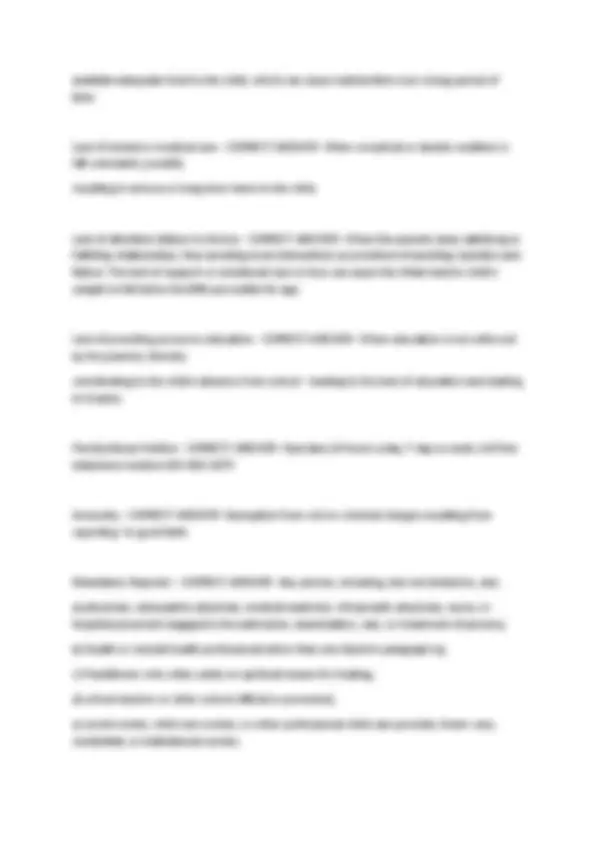
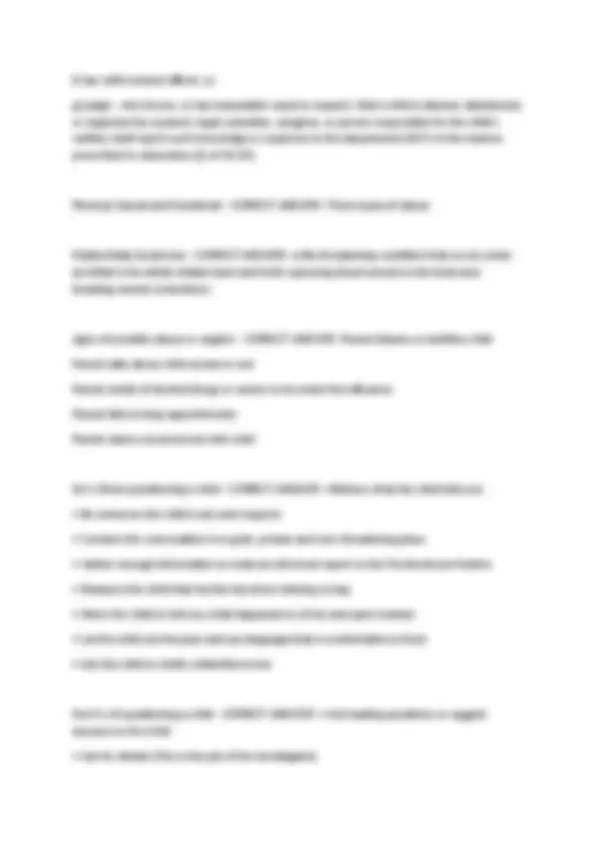
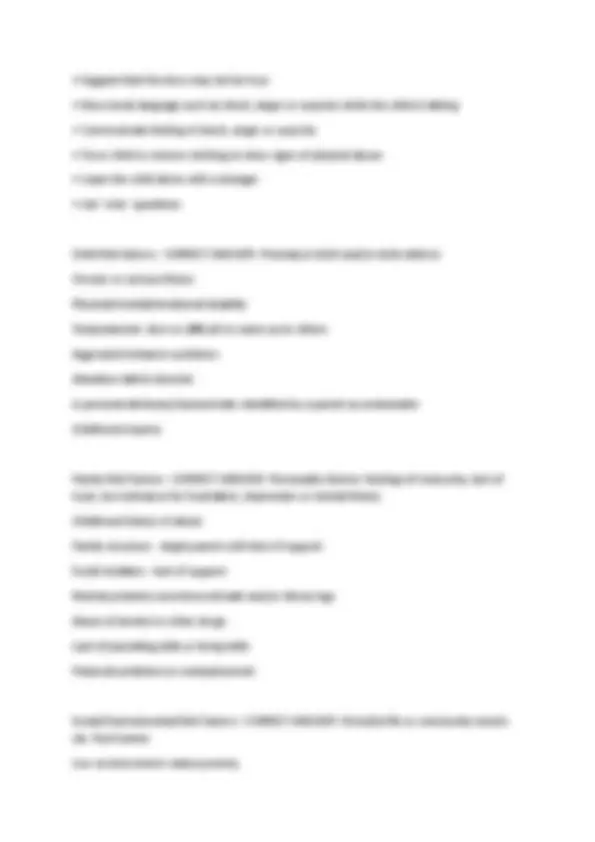
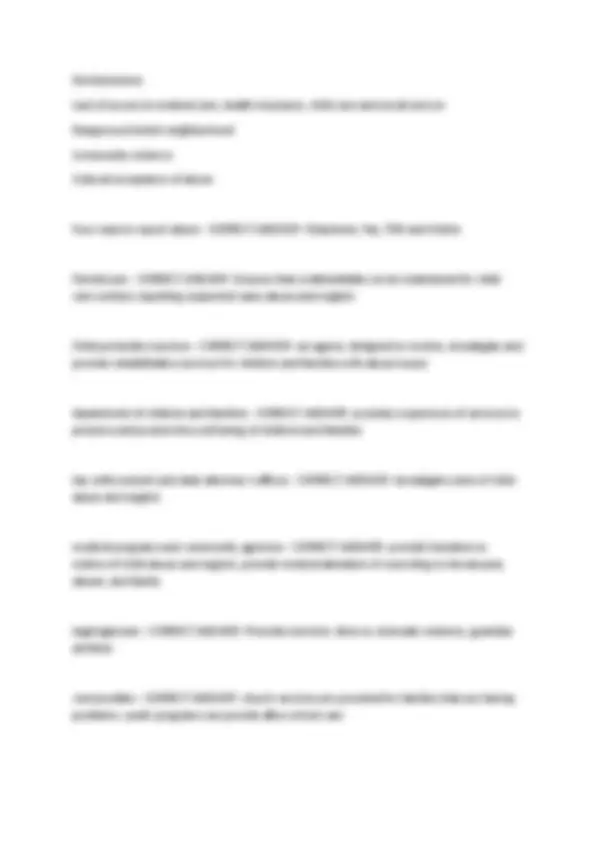
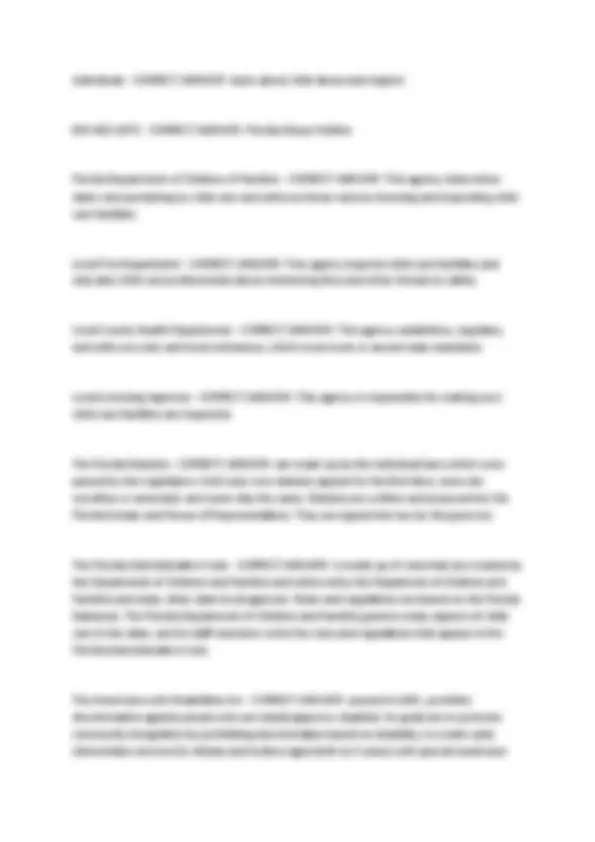
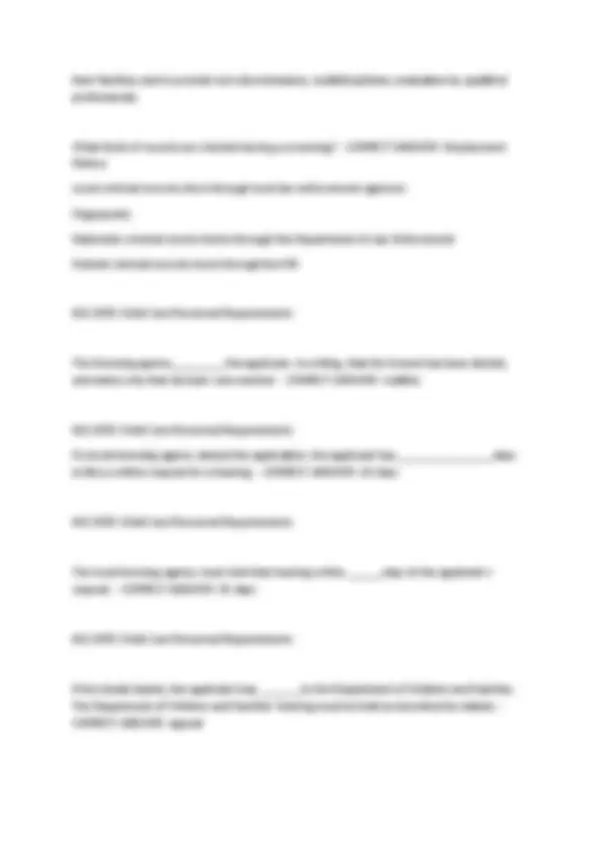
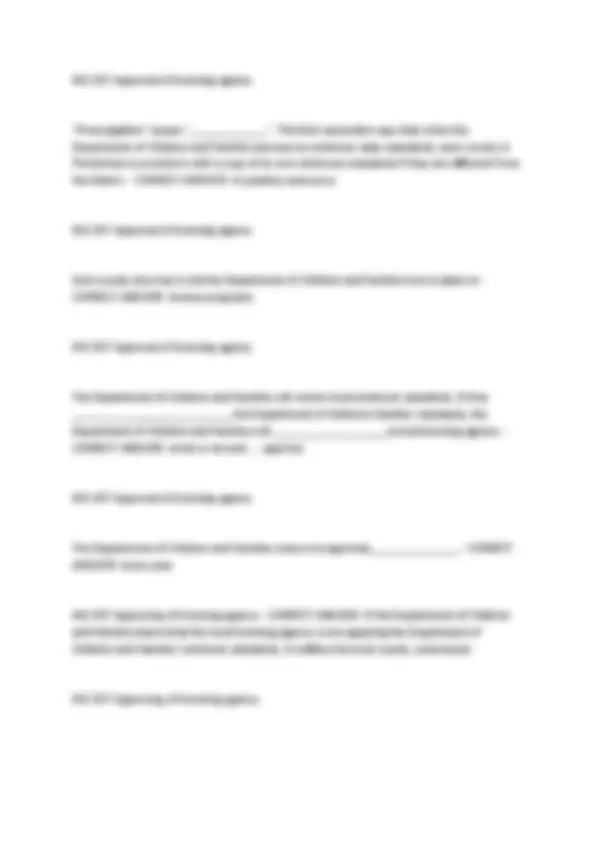
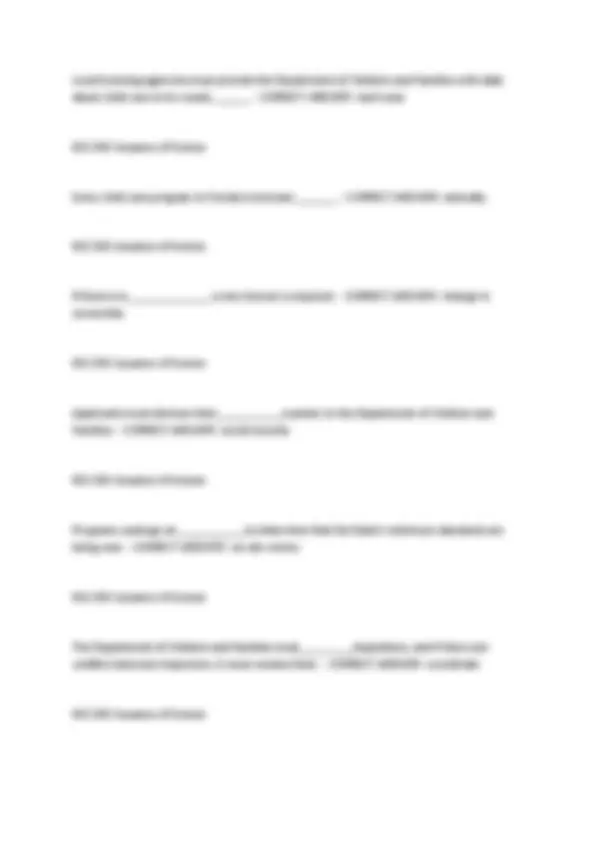
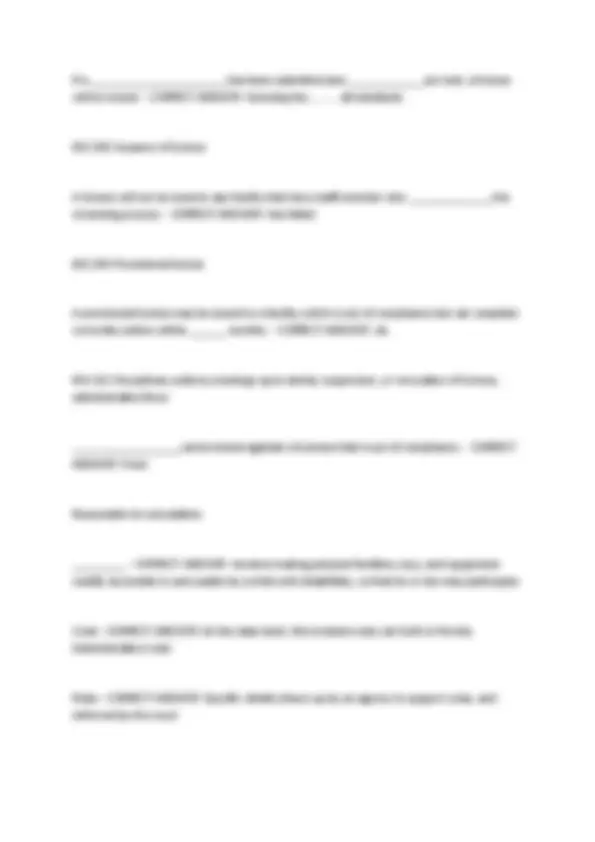
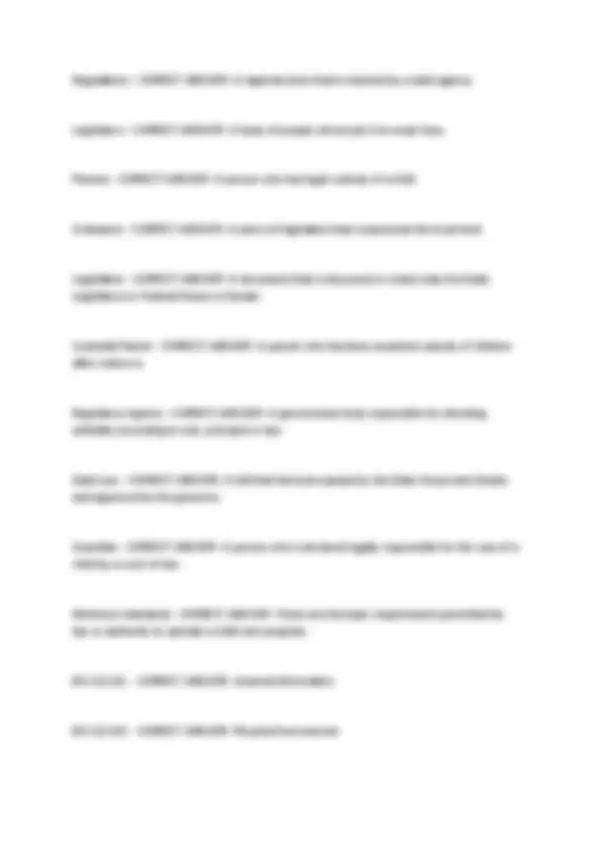

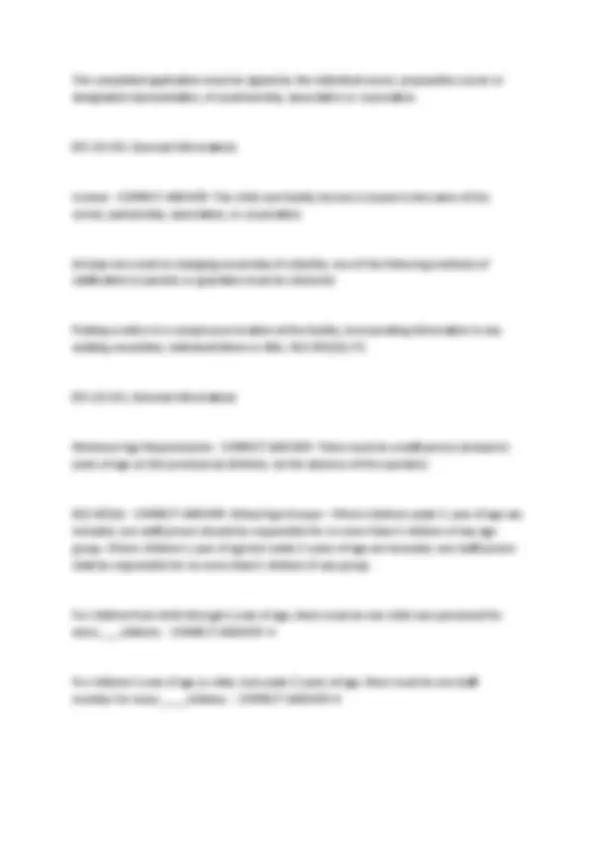
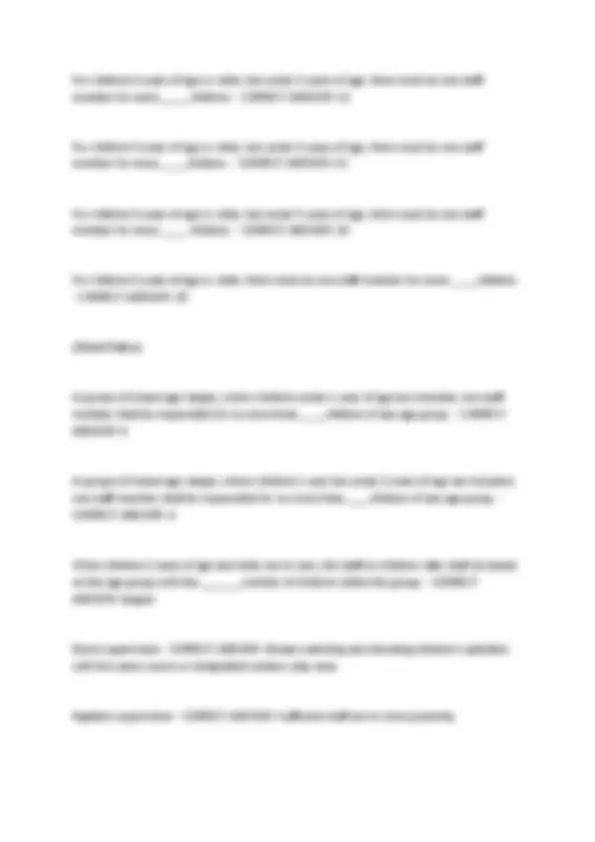
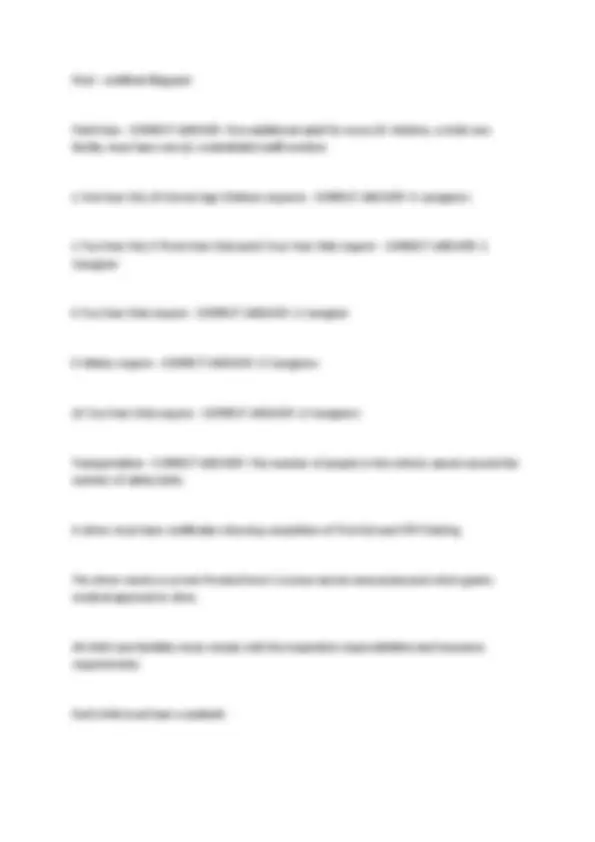
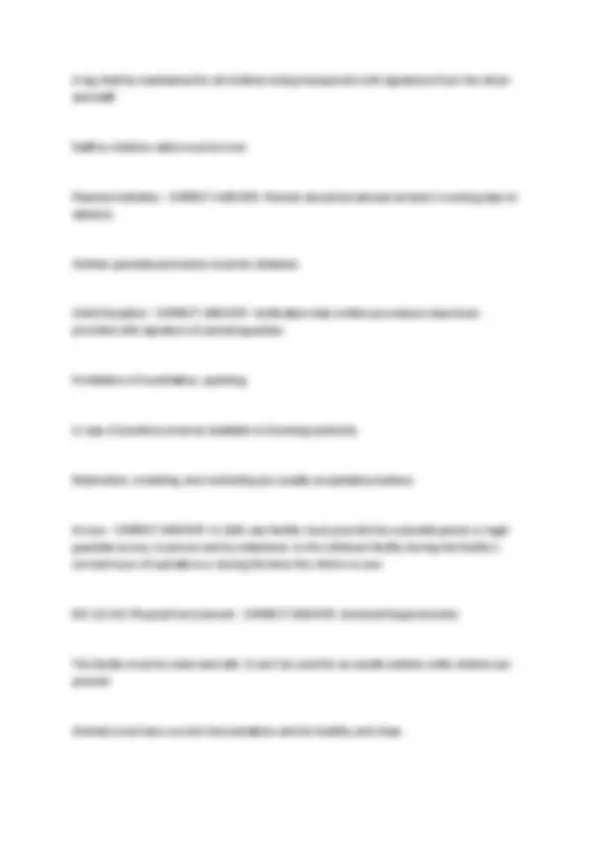
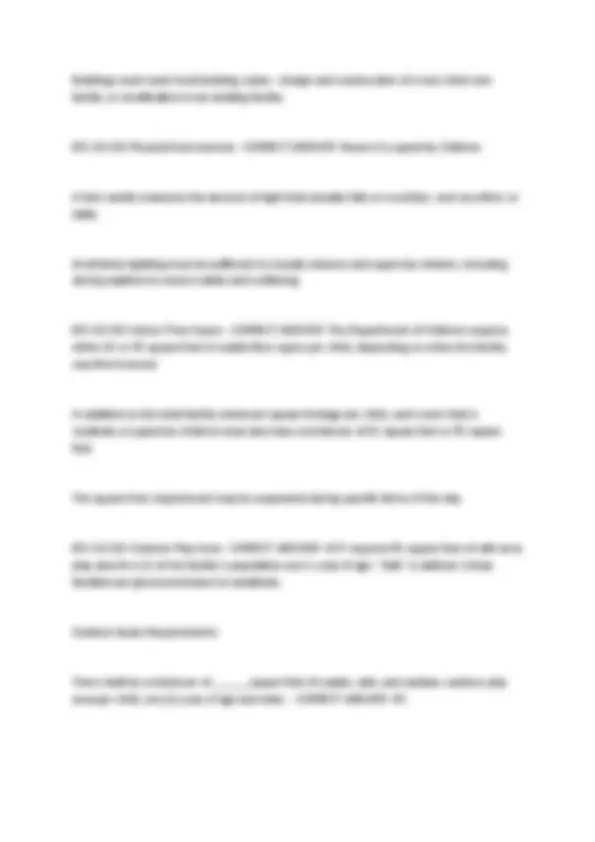
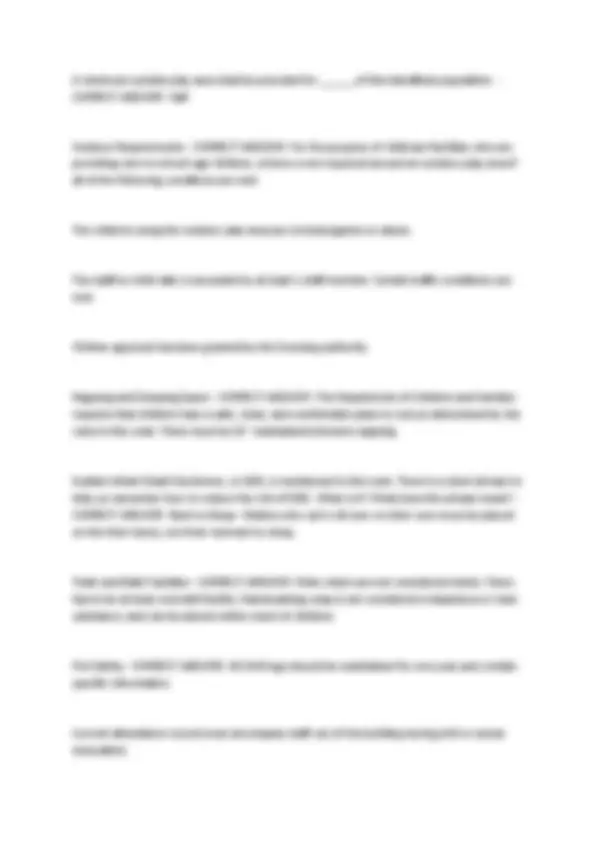
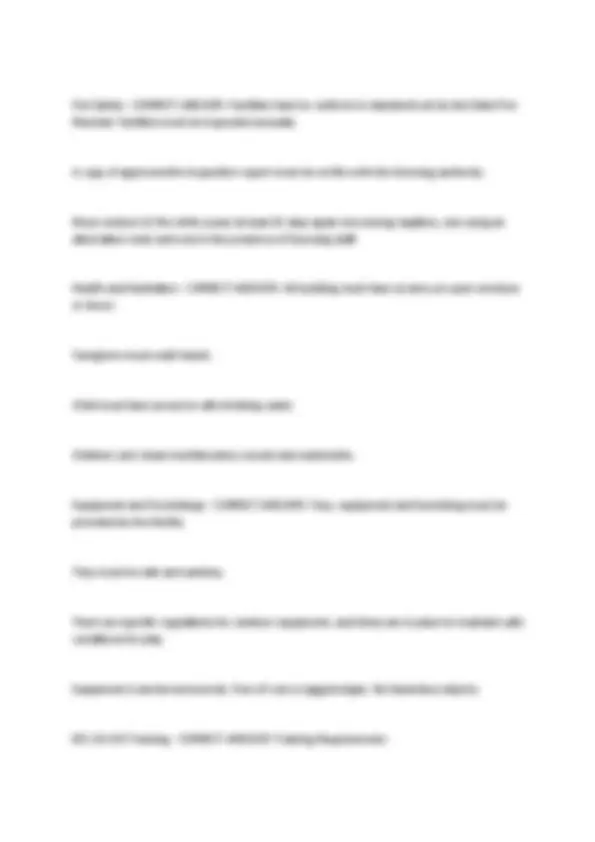
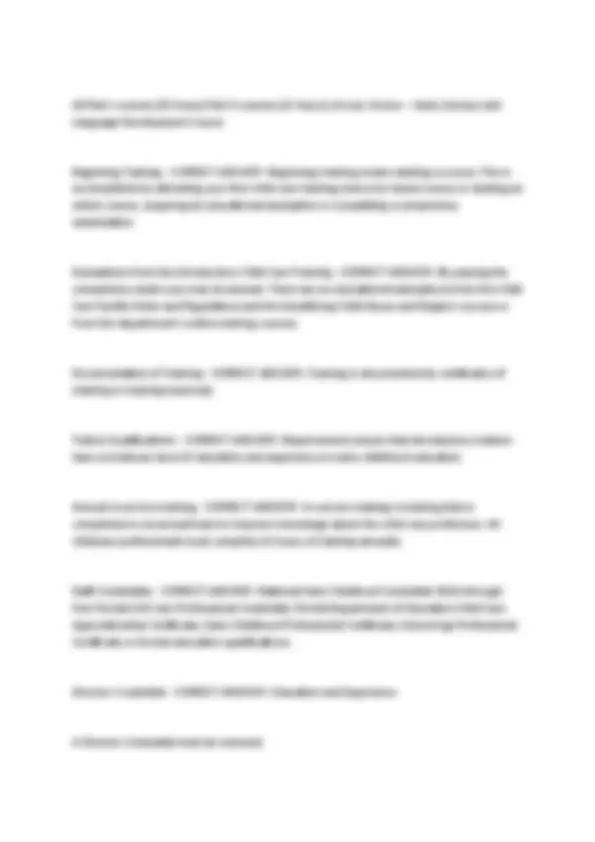
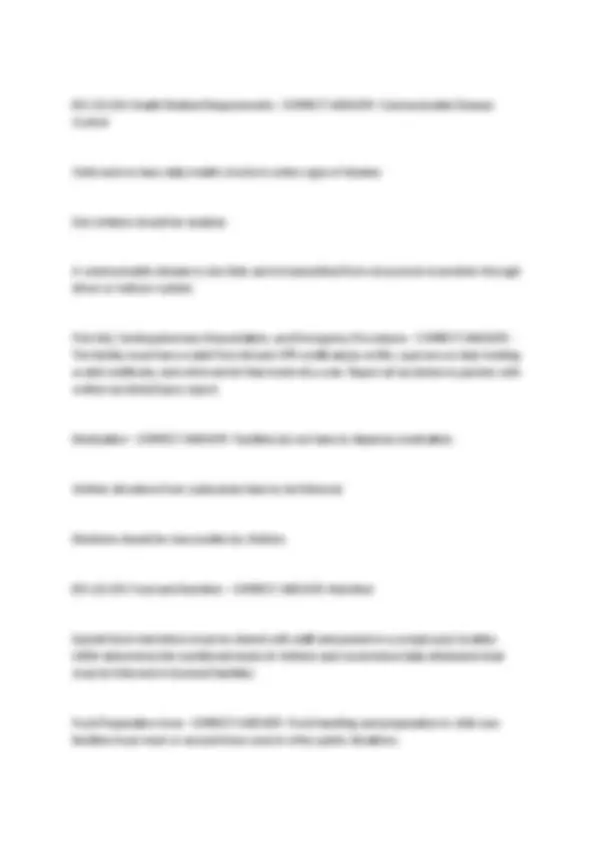
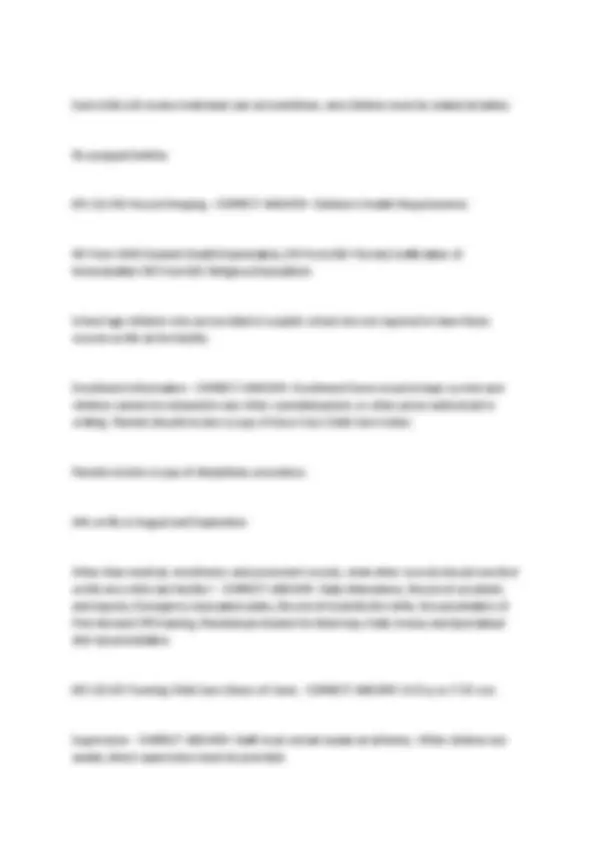
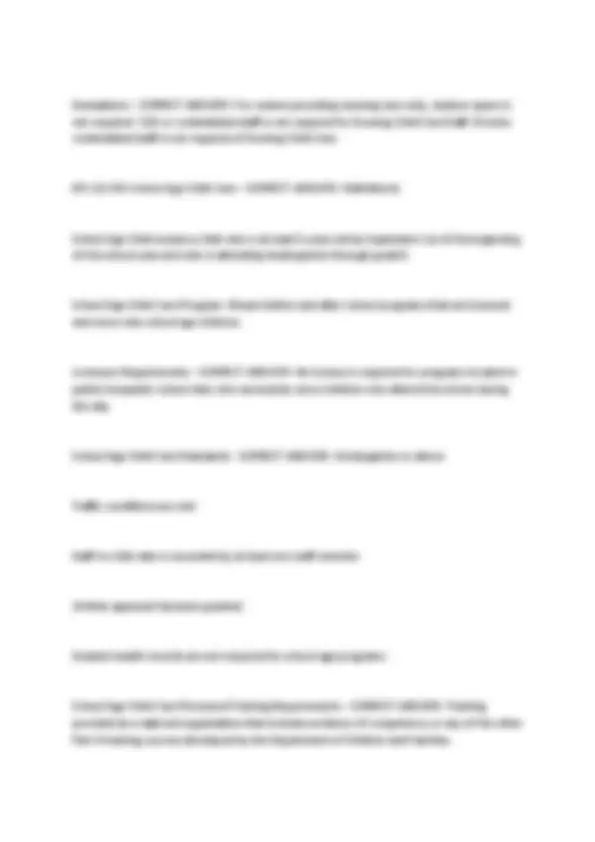
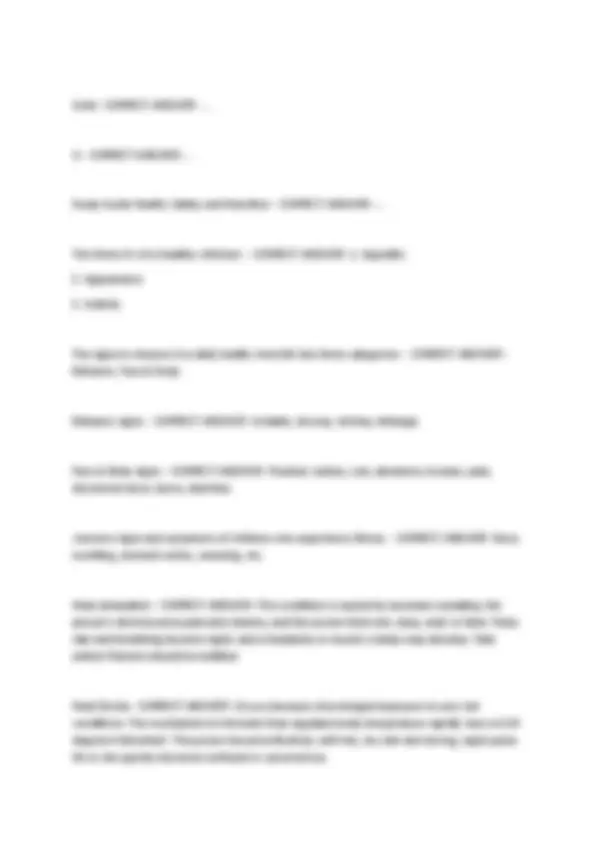
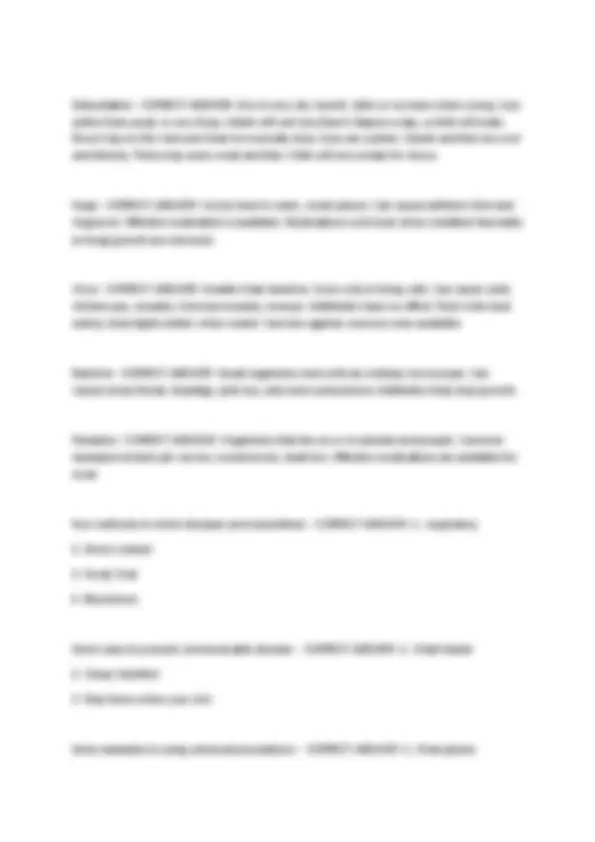
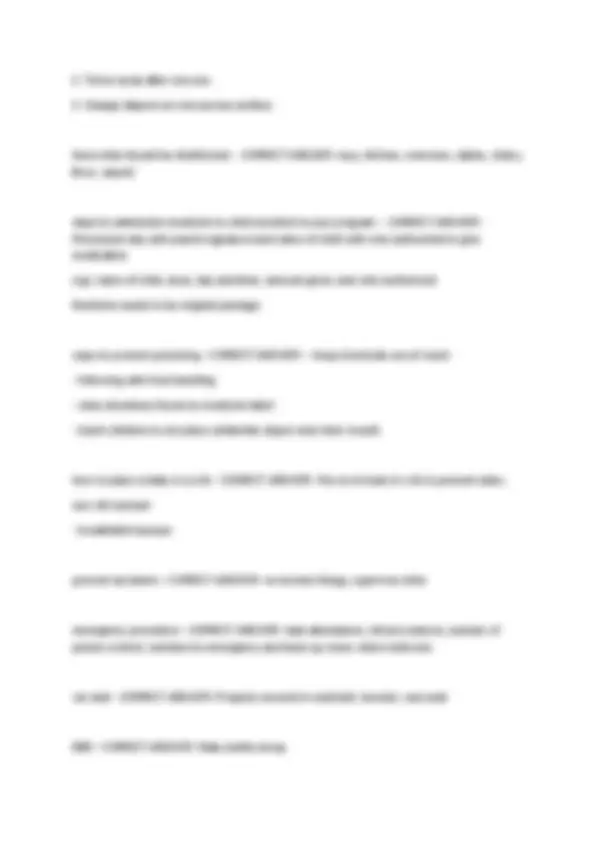
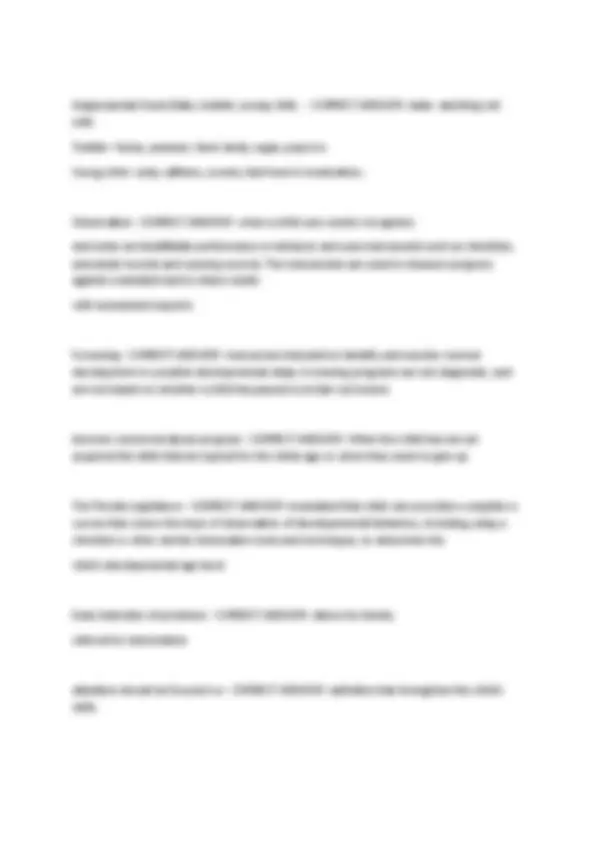
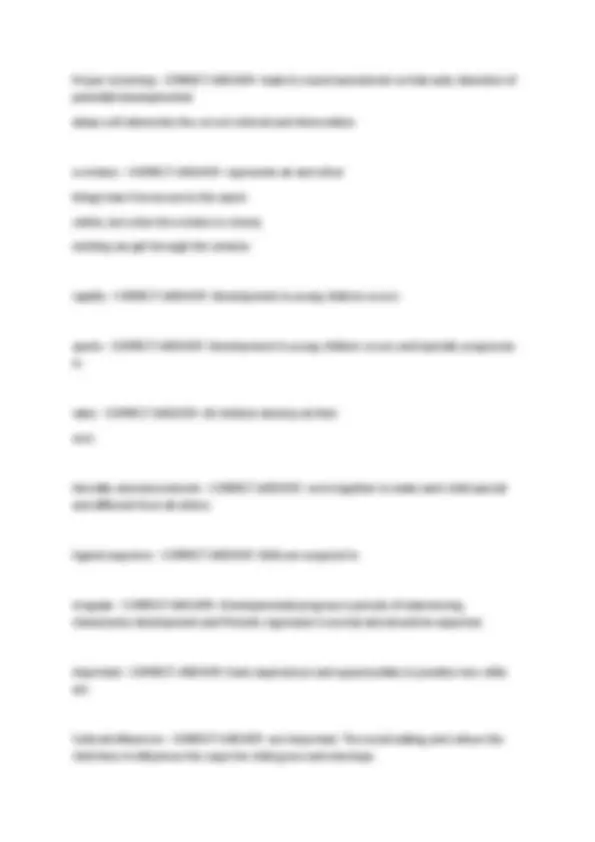
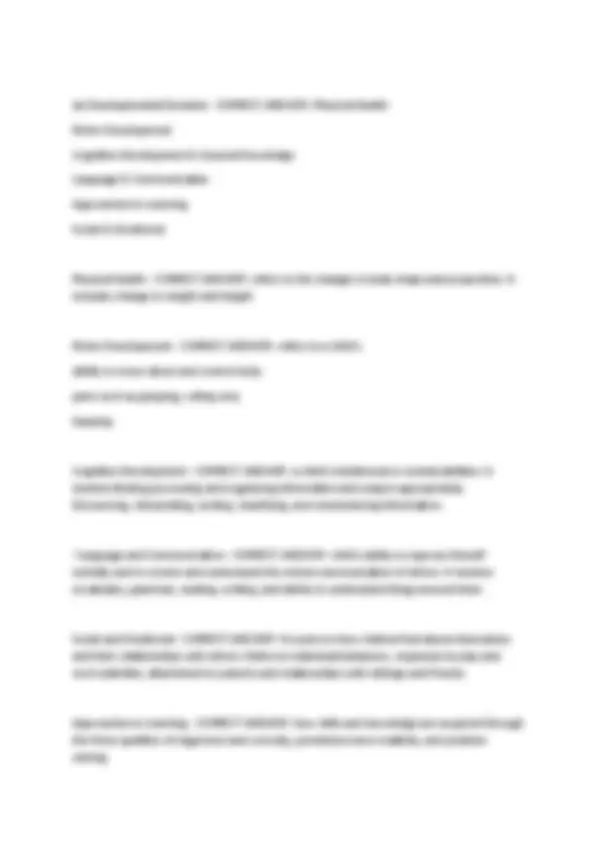
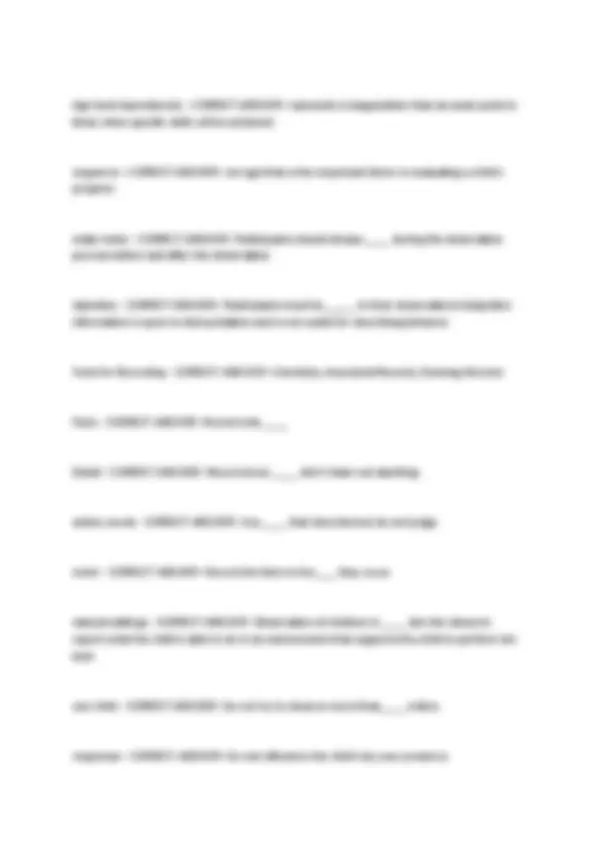
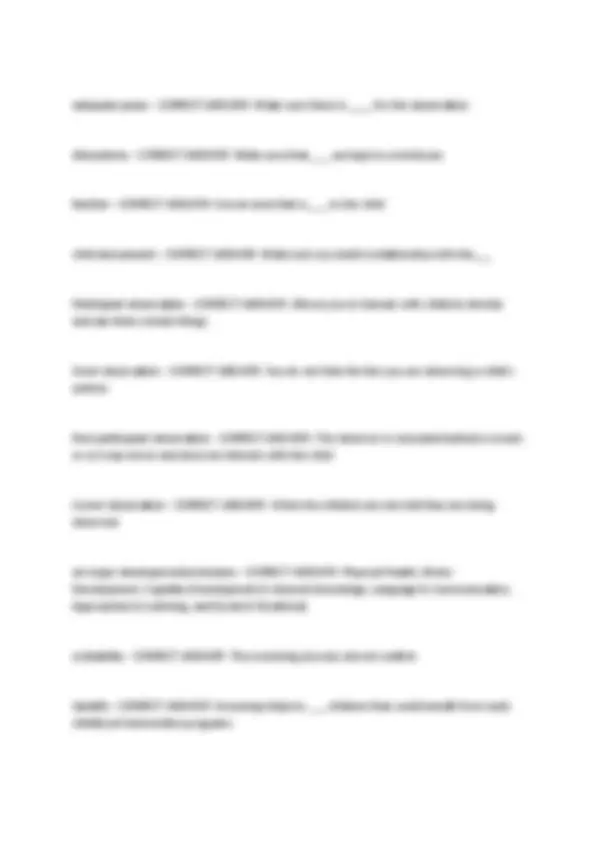
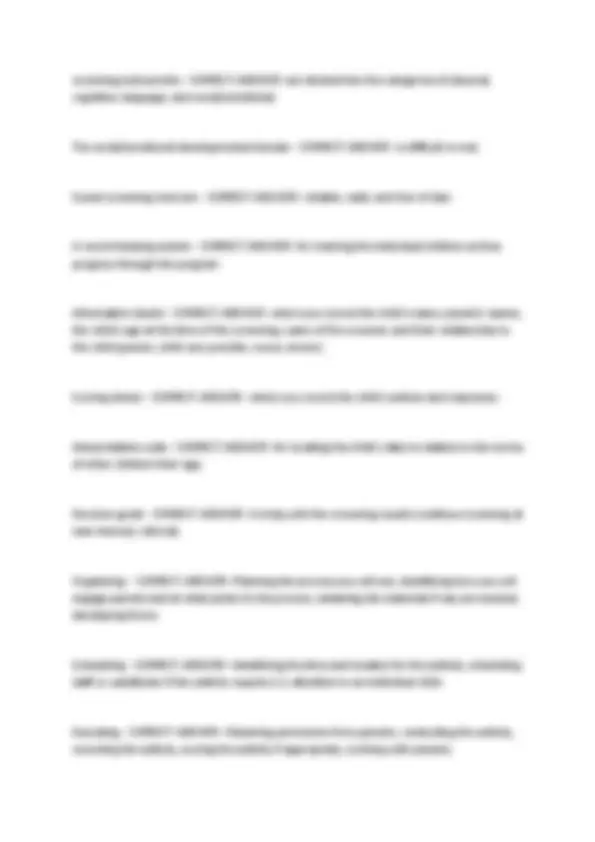
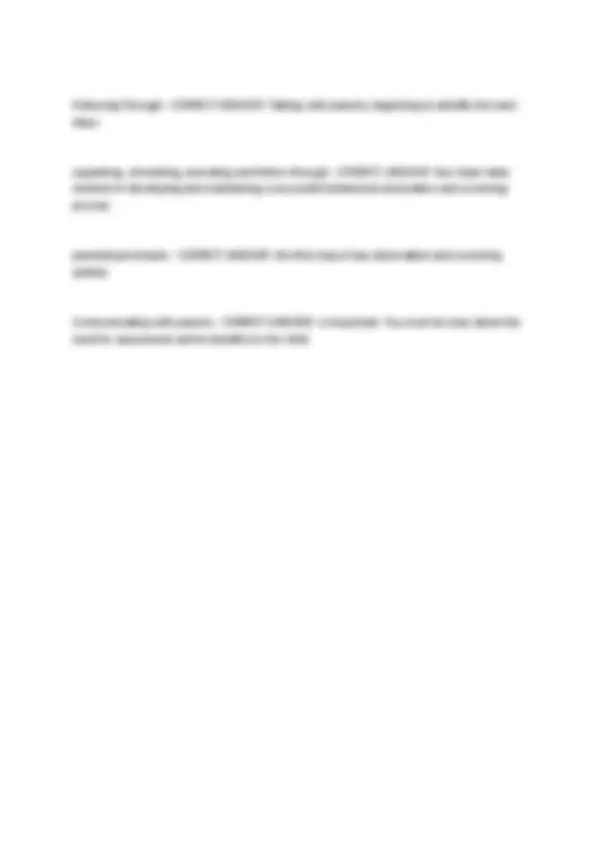


Study with the several resources on Docsity

Earn points by helping other students or get them with a premium plan


Prepare for your exams
Study with the several resources on Docsity

Earn points to download
Earn points by helping other students or get them with a premium plan
Community
Ask the community for help and clear up your study doubts
Discover the best universities in your country according to Docsity users
Free resources
Download our free guides on studying techniques, anxiety management strategies, and thesis advice from Docsity tutors
DCF CHILD CARE 40 HOUR CERTIFICATION EXAM 2024 ACTUAL EXAM COMPLETE 400 QUESTIONS WITH DETAILED VERIFIED ANSWERS / ALREADY GRADED A+ Why do childcare professionals observe and screen children? - CORRECT ANSWER -So they can facilitate the growth and development of every child in their program, detect early signs of development, delay or disability, and identify signs of child abuse or neglect. Observation - CORRECT ANSWER -an ongoing process in which child care professionals recognize and document identifiable developmental milestones as they appear using tools such as checklists, anecdotal records, and running records Screening - CORRECT ANSWER -is an ongoing process in which child care professionals use specialized observation and documentation tools to identify, document, and monitor typical development or possible developmental delay \
Typology: Exams
1 / 87

This page cannot be seen from the preview
Don't miss anything!
















































































Why do childcare professionals observe and screen children? - CORRECT ANSWER - So they can facilitate the growth and development of every child in their program, detect early signs of development, delay or disability, and identify signs of child abuse or neglect. Observation - CORRECT ANSWER - an ongoing process in which child care professionals recognize and document identifiable developmental milestones as they appear using tools such as checklists, anecdotal records, and running records Screening - CORRECT ANSWER - is an ongoing process in which child care professionals use specialized observation and documentation tools to identify, document, and monitor typical development or possible developmental delay Developmental milestones - CORRECT ANSWER - are observable behaviors, traits, skills, or abilities that typically appear at specific age ranges 3 main reasons child care programs observe and screen children are to: - CORRECT ANSWER --foster growth and development
Atypical - CORRECT ANSWER - same as not typical or not expected Mandatory Reporters - CORRECT ANSWER - people that must identify themselves and must report suspected abuse or neglect Documented evidence - CORRECT ANSWER - written data collected by the program Observation session - CORRECT ANSWER - trained adult monitors a child as they demonstrate identified skills or abilities within a developmental domain, in their natural environment Developmental Domain - CORRECT ANSWER - Characterize children's skills and abilties
Objectivity - CORRECT ANSWER - ability to set aside personal beliefs, values, opinions and biases, and consider only facts Subjectivity - CORRECT ANSWER - involves the application of one's point of view when determining a course of thought or action Presumption - CORRECT ANSWER - a belief about something or someone formed before experience shows it is true Good Faith - CORRECT ANSWER - moral concept that means to work with sincere intention of doing the right thing, with honesty and integrity and perform with best effort possible Validity - CORRECT ANSWER - screening instruments soundness and legitimacy Correlated - CORRECT ANSWER - related Replicated - CORRECT ANSWER - repeated Involving families in the prcoess - CORRECT ANSWER --permission to screen
Quality programs have developmentally appropriate screening schedule for each child and share it with the parents. The American Academy of Pediatrics recommends screenings at: - CORRECT ANSWER --9 months
Developmental disability - CORRECT ANSWER - chronic condition that is diagnosed in childhood and substantially limits major life activities in adulthood, and impacts a child's abilities to perform activities in one or more developmental domain Autism - CORRECT ANSWER - a group of neurodevelopmental disorders characterized by social impairments, communication difficulties, and restricted and repetitive patterns of behavior Down syndrome - CORRECT ANSWER - a genetic disorder characterized by distinct physical traits and intellectual impairments Genetic disorders - CORRECT ANSWER - conditions that are due to an abnormality in the way a body's cells are structures. if it is genetic it is present at birth, even if not diagnosed at the time Distinct physical - CORRECT ANSWER - traits refers to similar facial and body features shared by people with down syndrome Intellectual impairments - CORRECT ANSWER - means that people with Down Syndrome may have a difficult time understanding and processing info Self-help skills - CORRECT ANSWER - are a wide variety of abilities that are useful in every day life. Also know as adaptive behavior or adaptive skills ADHD - CORRECT ANSWER - a disorder characterized by impulsivity, inattention, and/or hyperactivity Cerebral Palsy - CORRECT ANSWER - a disorder that affects body movement and muscle coordination
Fetal Alcohol Syndrome - CORRECT ANSWER - a syndrome characterized deformities in the joints, fingers, and limbs; atypical behavior, learning disorders; and cognitive impairment Autism Spectrum - CORRECT ANSWER - a group of disorders characterized by social and communication impairments and restricted and repetitive patterns of behavior Cognitive Disabilities - CORRECT ANSWER - disabilities that affects self-help skills and the way the brain processes info Fragile X Syndrome - CORRECT ANSWER - a syndrome characterized by intellectual disability and behavior disorders, more prevalent and severe in males Bipolar Disorder - CORRECT ANSWER - a disorder characterized by extreme mood swings and shifts in energy Phenylketonuria (PKU) - CORRECT ANSWER - a disorder characterized by delays in motor development and seizures, it often appears in conjunction with a behavioral disorder The goal of the Infant and Toddler Appropriate Practices course - CORRECT ANSWER - is to guide child care professionals responsible for the care of children birth through 36 months through the principles of developmentally appropriate practice. Infant - CORRECT ANSWER - "infant" comes from the Latin word "infans" which means unable or incapable of speech. first stage of their life, until around 18 months of age. Toddler - CORRECT ANSWER - "toddle" means "to walk with short tottering steps," which makes a toddler a child who is just learning to walk. The term toddler is usually used to refer to children from 18 to 36 months.
redirection- empathy then redirect the attention of the child and help them move on Young Infants NAEYC - CORRECT ANSWER - birth to 9 months motivated by security Mobile Infants NAEYC - CORRECT ANSWER - engage in exploration 9- 18 months Toddlers NAEYC - CORRECT ANSWER - 18 - 36 months forming identity Who created DAP - CORRECT ANSWER - NAEYC National Association for the Education of Young Children Sensorimotor Stage - CORRECT ANSWER - by Piaget The sensorimotor stage takes place from birth to age two. During this stage children explore their world using their senses and motor skills. They like to touch and hold objects and toys such as rattles, dolls, or soft books. They also tend to explore objects using their mouths. They begin to understand the world by physically manipulating objects, and through trial and error problem solving. Trust vs Mistrust - CORRECT ANSWER - by Erikson This conflict is resolved when infants form bonds with their parents and caregivers and establish an emotional foundation through trust. As the basis for fulfilling the safety and comfort needs of infants, emotional security must be established through trusting relationships with adults. Children who do not experience positive, caring and loving attention from adults and caregivers can develop distrust for people around them and can result in poor emotional stability. Autonomy vs Shame & Doubt - CORRECT ANSWER - by Erikson
Stage 2 of Erikson's social theory deals with the conflict of autonomy vs. shame and doubt. This means that children need to be able to become independent and learn to problem solve on their own. As a caregiver you can encourage independence by allowing children to explore their environment in a safe and supervised manner. Children who explore and discover their environments will become confident about themselves and develop the ability to problem solve. Children also need to become aware of the physicality of their bodies. Engage children in games of pat-a-cake, tossing or rolling a ball, and manipulative toys that encourage children to use their hands. Install mobiles above infants' cribs to encourage them to look at and reach for the objects hanging down. 5 Areas Of Development - CORRECT ANSWER - Physical Development Social and Emotional Language and Communication Cognitive Development and General Knowledge Approaches to Learning Physical Development - CORRECT ANSWER - Infants Weight doubles in the first 6 months and triples by the 1st birthday. During this time infants require frequent feedings to aid in growth Infants grow 5 inches in length in the first 6 months and add 3 more by 9 months Toddlers Appear to grow slower than they did during infant stage Begin to walk without help Show interest in exploring their environment Begin to feed themselves and drink from a cup
Unknown why infants begin to express a social smile. Some people believe infants are "prewired" to smile at this age. Others believe smiling earns positive attention so infants begin to smile more. Infants will communicate by cooing and babbling before they learn to speak, and will eventually begin to make sounds that imitate the language of their culture. Cooing is important to caregivers because it indicates that a child is beginning to practice conversation. Can participate in "conversations" by taking turns making sounds; for example, when a caregiver speaks to an infant the infant will wait until they finish a phrase and then "coo" in response. Some infants even engage in "cooing" conversations when they are in adjacent cribs; these infants will take turns cooing in a simulated conversation. 3 - 7 months Vocalizes, responds to facial expressions (smiles when smiled at), and smiles intentionally. During feeding, many times infants will pause in their sucking. Mothers often gently jiggle the baby to have them start sucking again. This exchange is important because it keeps both the baby and mother interacting. Gazing is another powerful tool infants use to engage in social interaction. By gazing into a person's eyes, the baby is saying through body language, "I want to interact with you." Infants can also indicate when they are over stimulated. They will stop gazing (gaze aversion), turn their head, and may even begin to cry. 8 - 18 months
Show affection, such as hugs and kisses Become familiar with their surroundings Continue to use a comfort item when feeling stressed or tired Vocalize and point to get attention Recognize the name of a friend Initiate simple games and choose things to explore Pay attention to their reflec Senses - CORRECT ANSWER - Taste - Infants prefer sweet tastes. They may be predisposed to prefer the sweetness of breast milk. Sight - As newborns, infants are able to focus on objects 7 to 8 inches from their face. This may also be a predisposition because the average distance between a breast feeding baby and the mother's face is approximately 7 to 8 inches. Smell - Newborns also have a developed sense of smell. They react positively to sweet smells like vanilla and negatively to smells like rotten eggs. Infants who breast feed can also distinguish between their mother's smell and their father's smell. Hearing - Infants have the ability to hear even while they are still in the womb. Infants are able to distinguish between high and low sounds as well as loud and soft. Touch - Newborns also experience some degrees of pain. As infants grow and their nervous system develops, sensitivity to pain increases. Infants who experience pain have an increase in heart rate and blood pressure. Stress hormones like cortisol increase and they also exhibit behaviors like crying, irritability and prolonged wakefulness. Positive Guidance Strategies - CORRECT ANSWER - Positive guidance strategies are techniques to not only prevent difficult behavior but to address them once they happen. Guidance strategies differ drastically from punishment in that punishment is meant to control behavior through negative outcomes, where guidance strategies are designed to shape and encourage more acceptable behaviors Challenging Behaviors in Toddlers - CORRECT ANSWER - Temper tantrums, refusing to share, biting, saying no, throwing objects, putting objects in mouth, hitting, kicking, hair pulling,
Smaller group size Caregiver qualifications Professional development for staff Health and safety regulations Inclusive environment Process indicators - CORRECT ANSWER - are what programs "do" to help promote development through specific activities and intentional practices. Process indicators are observable interactions. EX: Curriculum and established routines Language and reasoning activities Sensitive, responsive interactions Collaboration and provisions for parents and families Parent, teacher, and child interactions Child-sized furnishings Well defined and equipped space that meets the needs of all children Studies suggest quality experiences early in life lead to better outcomes for children. These experiences lead to: - CORRECT ANSWER - Lower delinquency rates Increased graduation rates Adults who earn higher salaries Increased home ownership Better cognitive and language skills Adults who spend less time participating in social programs or on welfare Quality Preschool - CORRECT ANSWER - Developmentally appropriate curriculum Developmentally appropriate assessment procedures Continuous staff training
Administrative support Low teacher/student ratio Systematic effort to involve parents Quality Early Care + Quality Education = - CORRECT ANSWER - Quality Outcomes for Children High Quality Child Care - CORRECT ANSWER - High-quality child care is a safe, nurturing environment where children learn and grow. Staff are properly trained and supported. Parents have access to the program at all times and the program is well organized to promote optimal skill development. Motivational theories - CORRECT ANSWER - focus on the belief that humans are controlled by many factors. They place more emphasis on personal motivation and desires than on what is happening in the environment. Based on these theories, you might consider what motivates children to act the way they do. Social development theories - CORRECT ANSWER - focus on emotional and personality development. Psychosocial development helps children shape their personalities by strengthening their ability to successfully negotiate conflict during various stages. Each stage of development lays foundational patterns that influence a person's ability to resolve conflict throughout life. Intellectual/Cognitive development theories - CORRECT ANSWER - focus on children developing an intellectual understanding of their world. Children interact with materials and people in the environment to construct knowledge. Children are naturally curious about the world around them and they learn best when they are stimulated and interested in what they are doing. Abraham Maslow's Hierarchy of Needs - CORRECT ANSWER - This theory suggests children move through stages as certain needs are met. If basic needs are not met, children do not progress in development. Physical (Basic) Needs
Piaget's 4 Stages - CORRECT ANSWER - Sensorimotor (birth to approximately 2 years) - Children learn through sensory perception and motor activity. Preoperational (2 years to 7 years) - Children are bound by what they experience directly and not by what they think. Children begin to use symbols (one thing that represents another). For example, using sand to make a cake. Children are egocentric; their thinking centers on themselves. They can't see things from another point of view or from another perspective. For example, they do not realize that when they stand in front of the TV, no one else can see it. Concrete-Operational (7 years to 11 years) - Children become more rational in their thinking. For example, realizing that Santa Claus probably doesn't exist. Formal Operations (11 years and beyond) - The final stage of cognitive development, in which thinking becomes very abstract. Children think beyond the present and think about ideal situations. Vygotsky - CORRECT ANSWER - children create knowledge by interacting with their environment AND through social interactions, their culture and the use of language. Two developmental levels of ability: The ability to do something with help or assistance The ability to do something without help or assistance The distance between these two levels is called the "Zone of Proximal Development." Structure of a Neuron - CORRECT ANSWER - Neuron - specialized nerve cells that make up the central nervous system. Axon - Each neuron has one axon. An axon is a fiber that sends messages "away" to other neurons. Dendrites - Each neuron has many dendrites. Dendrites accept incoming messages from the axons.
How many neurons are in a brain at birth? - CORRECT ANSWER - When a child is born, there are already nearly 100 billion neurons in the child's brain. Physical Development - CORRECT ANSWER - Physical development refers to the development of large and small muscles as they gradually develop. It involves typical growth patterns, changes in weight and height, and general health and safety. Art Progression - CORRECT ANSWER - Children will typically progress from drawing free radicals into drawing basic shapes, such as circles, squares, rectangles, and triangles, then eventually drawing representations of people, places and ideas. By the age of three, children should begin to draw their first representations of the human form using basic shapes. free radical - CORRECT ANSWER - is a jumble of straight or curved lines that is freely floating on the paper. Writing Progression - CORRECT ANSWER - Writing begins to emerge as random scribbling and progresses to invented spelling in the kindergarten years. With enough opportunities to practice scribbling and writing, and with enough encouragement and enthusiasm from caregivers, children learn to write with increasing effectiveness and also understand the importance of written communication. Mildred Parten Four types of play - CORRECT ANSWER - Solitary play - playing alone Parallel play - playing beside other children, but not interacting with them Associative play - children play together with materials and some talking (3-5 years old) Cooperative play - children play together by planning and working toward a common goal ( years old through adolescence) Stages of Development - CORRECT ANSWER - Stages of development for young children are commonly clustered into domains related to physical development, language and